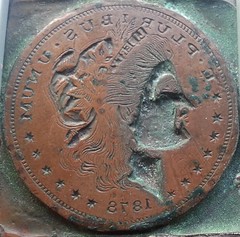
About UsThe Numismatic Bibliomania Society is a non-profit organization promoting numismatic literature. For more information please see our web site at coinbooks.org SubscriptionsThose wishing to become new E-Sylum subscribers (or wishing to Unsubscribe) can go to the following web page link MembershipThere is a membership application available on the web site Membership Application To join, print the application and return it with your check to the address printed on the application. Membership is only $20 to addresses in the U.S., $25 for First Class mail, and $30 elsewhere. For those without web access, write to: David M. Sundman, Treasurer AsylumFor Asylum mailing address changes and other membership questions, contact David at this email address: dsundman@LittletonCoin.com SubmissionsTo submit items for publication in The E-Sylum, just Reply to this message, or write to the Editor at this address: whomren@gmail.com
BUY THE BOOK BEFORE THE COIN |
- WAYNE'S WORDS: THE E-SYLUM AUGUST 31, 2014
- E-SYLUM ANNIVERSARY: SEPTEMBER 4, 2014
- NEW BOOK: U. S. FEDERAL LARGE-SIZE NOTES
- INTERVIEW: DOUG WINTER
- SHERATON COIN COMPANY FOUNDER ERNEST HENDERSON
- 1792 HALF DISME LISTING UPDATE
- NOTES FROM E-SYLUM READERS: AUGUST 31, 2014
- ANSWER: MORGAN DOLLAR PRINTING BLOCK
- THE AUGUSTIN DUPRÉ ARCHIVE
- MORE ON M. DAVID AND HULMEVILLE BANKNOTES
- 'NO GOD BUT ALLAH' OVERSTAMP REAPPEARS
- OPINIONS SOUGHT: POCKET PIECE VERSUS DISPLAY?
- HARVEY STACK ON THE U.S. MINT'S PROFITEERING
- THE NUMISMATIC EDUCATION OF DAVID T. ALEXANDER
- MACHINE-ENGRAVED GEOMETRIC PATTERNS ON BANKNOTES
- 1941 PHILIPPINE TREASURY NOTES
- CONFEDERATE QUARTERMASTER'S AGENT ORESTES PARMENO CHAFFEE
- NUMISMATIC GODFATHERS, LT. COLONELS, AND POOBAHS
- AAS ACCEPTS NATIONAL HUMANITIES MEDAL
- THE JONAS SALK CONGRESSIONAL GOLD MEDAL
- HOLEY DOLLAR AND DUMP STOLEN FROM LIBRARY
- THE NOTORIOUS COUNTERFEITER ALBERT TALTON
- BALDWINS HONG KONG COIN AUCTION 57 RESULTS
- KÜNKER AUCTION SALES 253-257
- GORNY & MOSCH AUCTION SALES 224-226
- RAREST CIRCULATING U.K. COINS
- FIGHT CONTINUES OVER 1974-D ALUMINUM CENT
- 3-D IMAGING REVEALS AND RECONSTRUCTS OBSCURED ARTIFACTS
- WHISKEY FLASK IN A HOLLOW BOOK
- ARTISTS LURES GOLDDIGGERS TO BRITISH BEACH
- CATCHING SMUGGLERS BY THE SMELL OF THEIR MONEY
- FEATURED WEB PAGE: ARTISTRY OF AFRICAN CURRENCY
Click here to access the complete archive
To comment or submit articles, reply to whomren@gmail.com
WAYNE'S WORDS: THE E-SYLUM AUGUST 31, 2014

New subscribers this week include: Carlson R. Chambliss, PhD, courtesy of John and Nancy Wilson. Welcome aboard! We now have 1,761 subscribers.
Many thanks to those who sent birthday greetings, including Tony Lopez, Harry Cabluck, Joel Iskowitz, Bob Hurst, Jeff Starck and others.
This week we open with an
Other topics include Sheraton Coin Company founder Ernest Henderson, the Augustin Dupré archive, Mauritius/Moses/ Moritz David, Philippine Treasury Notes, machine-engraved geometric patterns, Monnaie de Paris, Niue, POTUS and FLOTUS, and counterfeiter Albert Talton.
To learn more about David T. Alexander, Hiram Deats, Jonas Salk, the smell of money, U.S. Mint profiteering, Baby Bonds, the tax on Tea Party tea, pocket pieces, caryatids, volutes, gabanga, the 1674 Emden double reichsthaler and Blackbeard’s booty, read on. Have a great week, everyone!
Wayne Homren
In the mid 1990s Wayne Homren hoped to start an email newsletter for members of the Numismatic Bibliomania Society, a group founded in 1979 to promote the study and collecting of numismatic literature. Every year at the group's annual meeting he asked for a show of hands to see who else had an email account.
At first cataloguer Michael Hodder was the only other person to raise a hand. As they exchanged email addresses the others looked on like they were witnessing some secret ritual. In subsequent years a few more hands went up. Finally at the 1998 meeting in Portland, OR nearly every hand went up. Wayne grabbed a tablet of paper and passed it around to collect email addresses. On September 4, 1998 the first issue of what is now called The E-Sylum was published in an email message to 49 people. As the word spread subscription requests arrived from around the world and by September 15 there were 90 subscribers.
The original announcement noted "This is intended to be a moderated, low-volume mailing list, with no more than one message every week or so. Its purpose and use will evolve over time - please send us your comments and suggestions."
The E-Sylum has evolved into a weekly forum where "numismatic bibliophiles, researchers and just plain collectors" congregate to exchange information and ideas about numismatics and numismatic research. Most of the top numismatic authors, curators and collectors around the U.S. are subscribers, as well as a number from around the world. Today each issue is read by over 1,100 subscribers in the U.S., Canada, Mexico, England, Ireland, Wales, Germany, Denmark, Italy, Australia, New Zealand and elsewhere. It's been described as a weekly cocktail party of the world's top numismatic minds.
A typical issue could have anywhere from 15 to 30 pages of material arranged loosely into sections containing Numismatic Bibliomania Society news and announcements, numismatic literature sale announcements, book publication announcements, reviews of books and auction catalogs, answers to previous research queries, new research queries, excerpts of newspaper stories relating to numismatics, a humorous numismatic story and a Featured Web Site.
Topics are all over the numismatic map - anything interesting is fair game, and obscure topics are welcomed. Over the years subjects of discussion have included contemporary newspaper accounts of new coinage, biographies of numismatic authors and personalities, celebrity numismatists, numismatic ne'er-do-wells, the largest numismatics books, the most expensive numismatic books, counterfeiters, alternate currencies, rare medals, sunken treasure, archeological finds, and coins placed under a ship's mast or on a cadaver's eyes.
To read the complete set of 17,840 E-Sylum articles published through last week, see:
E-Sylum Contents - All issues
(www.coinbooks.org/esylum_toc.html)
The book is a 320 page, soft-bound reference (8.5” X 11”), fully illustrated with vivid color photographs. This is the first reference since 1979 to deal with large-size notes exclusively. Notes in denominations from $1 to $10,000 are covered in three grades. Many of the notes shown in this reference are in the collection of Dr. Chambliss. The reference also covers (US Federal issues), currency related souvenir cards, with prices and quantity sold, along with how they came into existence starting in 1969. The authors introduce a new and very systematic (Chambliss) numbering system. The more familiar Friedberg numbers are also given for each variety. Star notes, mules, and National bank notes, large-size errors, fancy serial numbers and uncut sheets are also covered. All census data is covered to 2014.
Ink, chemistry, bimetallism, monetary policies of the 19th century and other such features are also covered. The reference has 14 Chapters. These two authors have worked together on a previous reference dealing with paper money. That was in 2006 when they authored, “The Comprehensive Catalog of U. S. Paper Money.” Dr. Chambliss is an author of about 90 articles mostly on paper money. He has also authored other numismatic references. Gene Hessler (a recent recipient of the American Numismatic Association, Lifetime Achievement Award) is a celebrated author and researcher.
Chapter One - Introduction. The authors cover the many complexities of U. S. paper money. You will learn ink variances, the placement of notes on sheets, plate letters, Treasury seals, and serial numbers.
Chapter Two – Signatures and Seals. Treasury officials whose signatures appear on notes from 4-17-1861 to 5-31-1933 are given. They explain how the Treasury Seal came into existence and two pages of the Seals are shown and defined.
Chapter Three – Grading and Valuations. The authors describe grades from Gem to Good. An explanation of Third-party grading is also given. They cover purchasing notes in auctions which are slabbed as well as the slabbing of notes. They are currently working on a new “Eighth Edition of their Comprehensive Catalog.” This reference “will contain a more thorough discussion of third-party grading. They also explain in great detail how their pricing would compare to other references including the monthly Currency Dealer Newsletter or Greensheet. Counterfeit and replica notes close out this chapter.
Chapters 4 to 12 cover all the different large size notes that were issued from 1861 to 1929. The 226 pages in these chapters explain the Laws that authorized the different issues and the reasons they came into existence. They give the quantities of notes issued, notes known, and with the exception of some issues, prices in three different grades, F, XF and CU. The chapter on Demand and Interest Bearing Notes has important information found no-place else. The chapter on National bank notes has a listing and values by states. The prices utilize actual auction selling prices and other sources.
Chapter Thirteen – Errors, Fancies, and Sheet. The chapter has an excellent explanation of how an error occurs. An explanation of plate errors is followed with a two page census on inverted backs. The 2010 listing of inverted varieties was done by Martin Gengerke and Dr. Fred Bart. They are listed by denominations, types, CH# (Chambliss No.) and census (No. of notes known). The majority have only one note in the census. Other errors include overprint errors, double denominations (the authors explain that very few large size double denominations are known), mismatched serial numbers and fancy serial numbers. A listing of large size uncut sheets close out this interesting and informative section.
Chapter Fourteen – Currency Related Souvenir Cards. With the high cost of any large size note, many collectors have turned to collecting currency related souvenir cards. We collect all currency related souvenir cards including forerunner issues. The Bureau of Engraving and Printing (BEP) started selling souvenir cards in 1969 and still do today. Some years back they stopped issuing cards that depicted U. S. currency. The BEP used the actual plates to print these currency related cards along with any of the cards that are issued today. The cards are listed by: year of issue, event they were sold at, the name of the note used, quantity issued, and current price trend. We know of at least two dealers who sell them on Ebay and other venues. There is also a society for the collecting of souvenir cards. The Souvenir Card Collecting is a great organization that publishes a journal quarterly. If you have an interest in collecting Souvenir Cards the dues is $25 per year if you live in North America. Dues can be sent to: William Kriebel, 1923 Manning Street, Philadelphia, PA 19103-5728.
Mediography – References or Bibliography . These are the sources that were used to produce this reference. The “Auction Catalogs” part gives information on sales and auctions that had rare and important U.S. currency.
The pages following contain the Gengerke census of U. S. Large Size Type Notes. The census lists over 150,000 notes that are individually listed by serial numbers and by grades. Auction data is also provided by Mr. Gengerke in this census. If you have an interest in purchasing this census Email Martin Gengerke at: Gengerke@aol.com.
Dr. Chambliss and Mr. Hessler have gone “the extra mile” in providing a reference destined to help anyone interested in U. S. Federal Currency. We highly recommend collectors, dealers, investors and researchers purchase this wonderful reference on U. S. Federal Large-Size Notes, 1861 – 1929. The book is available from the author for $35, which includes postage and handling. Send a check to: Carlson R. Chambliss, P. O. Box 804, Kutztown, PA. 19530 or call 1 (610) 683-6572 or email crchamblis@verizon.net
DW: I met David when I was in my twenties. He was someone I was always in awe of. I was intimidated by him at first. He was also very helpful to me and was definitely somebody that inspired me.
One of the ways he inspired me when I was younger, in my 20s in the 1980s, was the way Akers would walk in to an auction and he’d buy the three or four coins I could only dream about buying… and then he’d get up and leave.
I thought, someday I want to get to the point where I don’t have to sit through a 3,000 coin auction to find a coin here and there that slipped through the cracks.
His books were a huge bellwether for the market. For the first time, Akers put all the information about classic U.S. gold in one place. For a lot of people, the books stirred an interest in gold coins. And while I don’t use the books anymore because they are more or less out of date, I can say that if you read the comments Akers made about the coins 30 years ago, they turn out to be amazingly accurate.
DW: I used the Akers books as a little bit of an inspiration, actually. But what I’ve always tried to do with any book that I’ve written is I’ve tried to make the books a guide that can be used by collectors at all levels. I want my books to be useful for beginners and experts. So, my goal wasn’t to provide historical background or mint research, but instead, what I’ve tried to do is to give collectors a feel about each issue in a series: what it’s strike is like, how the surfaces come, what range of colors should you expect, how to gauge the quality of the coin’s luster.
My books are written to give collectors an idea of what they are looking at and what they should be looking for. They are essentially buyers’ guides. If you are making a decision to buy a coin, the information in the books Mike and I wrote is useful.
CM: Do you think the two of you will revisit that series and update them?
DW: I’d love to, but the problem is time. These days I’ve put more focus on writing shorter articles that go up on my website and on CoinWeek. But some of the things I want to do in the next couple of years: Redo my Carson City book because it’s hugely out of date. Do another edition of the New Orleans book. And I’d like to write something on San Francisco coinage, but that’s a really time intensive endeavor.
To read the complete article, see:
CoinWeek Q&A with U.S. Gold Coin Expert Douglas Winter
(www.coinweek.com/marketplace/coinweek-qa-u-s-gold-coin-expert-douglas-winter/)
I can contribute some knowledge on this since I am one of Henderson’s daughters. My sisters, Augusta Henderson Petrone and Victoria Osborne are his other daughters, and my brother Barclay Henderson is his surviving son. As for myself, I’ve written about my late husband (Frank Perdue) and his role in collecting coins from the Atocha, including becoming one of the financial backers for the recovery of the treasure ship, Atocha.
He used to tell us stories, which I wish I could remember better, about the more unusual coins in his collection, including excellent fakes, and even pennies from years when none were actually minted. I think his enjoyment of coins included admiration of the beauty of individual l coins, but he also relished their histories. It also made him exceptionally happy when he could acquire a coin that would fill in a blank in his collection.
I know the entire collection was sold at auction 67 years ago, August 26th, and also 27th, at the American Numismatic Association convention auction sale. I know the date because Greg Rohan from Heritage Auctions was kind enough to send me a copy of the auction catalogue. I have no idea why Father sold the collection, or what was going on in his life in 1947 that may have made this a necessity. For me, it’s a complete puzzle, given how much he loved the collection.
I’ll close with a quick story about my father and coins:
Father was a history buff, as would be predicted from having a father who was a history professor. At one of his dinners, his interest in history and coins enabled him to do something that actually changed history. But alas, almost no one knows about it.
Ah, but in mere moments, you Dear Reader, will know about it. At one of the dinner parties at 8 Louisburg Square he entertained the British ambassador, Baron Caccia of Abernant. At the end of the dinner, instead of serving coffee, as would have been usual, Father served tea.
But the tea was no ordinary tea. Father had once done a favor for a doctor, who in return gave him a small, blue, antique porcelain jar that contained 200-year old tea taken from the Boston Tea Party.
The men who started the American Revolution by dumping tea into the Boston Harbor were also frugal New England Yankees, and although they did dump a bale or two of tea into the harbor, most of the tea ended up in New England kitchens, heartily enjoyed.
But not all of it. Some of the revolutionaries/thieves, recognizing that the tea had historic significance, handed it down to their children, who handed it down to their children and so on until about a quarter of a cup’s worth reached my father.
I heard my father go on to explain that he had looked up the amount of the tax, and it was actually a small amount. Father had gone to a coin dealer (he collected coins so this was an easy thing for him to do), and bought antique coins that would actually cover the taxes that America owed on the tea that had been dumped.
Father produced an antique-looking leather purse and with a flourish, handed the purse with its coins to the ambassador.
I watched as the ambassador opened the strings of the purse, poured the coins into his palm, and then counted them. “I accept these on behalf of my government and Her Majesty, the Queen,” Baron Caccia intoned in an official-sounding voice, but then added in a graver, and still more official-sounding voice, “However, the interest on the indebtedness means that these coins do not cover the amount owed.”
He paused for drama, and then:
"In my role as ambassador, I am allowed to represent Her Majesty the Queen's government in overseas matters relating to taxes and duties. In that role, I forgive all interest accrued on this debt and pronounce the taxes now paid in full.”
And thus history was made.
I bet it was an evening that everyone present remembered a long time. What a gift for showmanship Father had!
That’s the end of my story about Ernest Henderson.
Sincerely,
Mitzi Perdue adds:
I keep thinking how pleased I am that I came across your website. My siblings have all written to say how pleased they are that we’re all remembering such an important part of our father’s life.
To read the earlier E-Sylum article, see:
ROBERT HENDERSON AND THE SHERATON COIN COMPANY
(www.coinbooks.org/esylum_v14n02a18.html)
I have now received two reports of a coin for sale at the ANA that I did not see. The person reporting could not recall what dealer had it. This is frustrating and a missed opportunity.
The coin may show up at a local or regional show that I don't attend. I would appreciate reports with the name of the dealer and really appreciate reports with the certification number.
In the past year there have been six pieces for sale that I have seen in hand or in photos. I have reports of another three to five that are supposed to be on the market that I have not seen. The research will continue until we get much closer to publication.
To read the earlier E-Sylum article, see:
1792 HALF DISME LISTING ASSISTANCE SOUGHT
(www.coinbooks.org/esylum_v17n34a06.html)
Query: Monnaie de Paris Commemorative Medal Catalog
Tom Garver writes:
It seems to me that when I was doing some research a few months ago, I ran across a reference to an illustrated catalogue of commemorative medals produced across a certain time period by the Monnaie de Paris.
As numismatic bibliophiles, can anyone tell me more about this (these) publication(s)? If they are historical, have they been reissued on CD or available through the Google listings? (I've looked there, but may not be entering my search information correctly).
Query: Information on Dave Hess Sought
Douglas Saville writes:
I wonder if anyone reading The E-Sylum might know anything about Dave Hess - a dealer based in Baton Rouge, Louisiana during the 1960s and 1970s. He issued lists, similar to the Seaby Bulletins, complete with good articles, mostly on British numismatics, and was a frequent traveller to the UK, attending coin shows and auctions in London. I understand he may have passed away some years ago - is there an obituary or any other information about him anywhere? I am sure some of your readers will have some information about him.
Canadian Numismatic Bibliography CD Now Shipping
Greg Burns writes:
I see from perusing my incoming mail today that the Canadian Numismatic Bibliography folks have started shipping the CDs containing the searchable PDF (and Microsoft Excel) files for the two volumes. Certainly makes the original purchase of the book set much more useful; how considerate of the project folks and supporters to push these out to the subscribers…a very welcome addition to the original purchase! Photo of the CD and mailer attached.
To read the earlier E-Sylum article, see:
CANADIAN NUMISMATIC BIBLIOGRAPHY AVAILABLE ON CD
(www.coinbooks.org/esylum_v17n32a05.html)
Quick Quiz: Who is This Mystery Numismatist?
I came across this picture on Tuesday, and thought it would make an interesting 'mystery numismatist' quiz.
2014 ANA Exhibit Winners Posted
Did you attend the World's Fair of Money? Did you visit the Collector Exhibit Area? The redesigned ANA web site now has a listing of which exhibits won which awards, at
http://www.money.org/blog/2014wfmexhibitawards
.
This posting also provides excerpts from Mack Martin's Best of Show-winning exhibit on Baby Bonds.
The Collector Exhibits Area had a wide range of material. Don't take my word for it -- look at the on-line guide available to see what you missed, at:
http://www.money.org/blog/collector-exhibit-guide-2014-wfm
.
Unfortunately, there were no exhibits of Numismatic Literature -- so we all missed out in one way.
If you did not exhibit this year, please consider exhibiting next year
-- one last year in Chicago/Rosemont before it goes back on the road (to Anaheim, Denver, and Philadelphia).
'Breaking Bad' Image Confirmed
Chris Fuccione writes:
To read the complete article, see:
'Breaking Bad' Season 5 Episode 10 In GIFs: 'Buried' Moments From Slaps To Foot-Fetishes [PHOTOS]
(www.ibtimes.com/breaking-bad-season-5-episode-10-gifs-buried-moments-slaps-foot-fetishes-photos-1390475)
To read the earlier E-Sylum articles, see:
Niue - A New Zealand Dependency
Martin Purdy writes:
The countries presumably get a share of the sales revenue, which helps their economies, in return for lending their names to these commercial exercises to give what would otherwise just be "medals" an air of legitimacy, since they can then be called "legal tender". I do wonder how many of these items are ever actually seen in the territories of Niue or the Cooks, however. Their legal tender status is even dubious, as cashing them could prove problematic - didn't someone try doing just that with a stash of high-denomination silver "coins" a few years ago and found as a result that they would not be honoured?
The Niuean language, by the way, is a Polynesian language not totally unlike Maori. The island must have been a welcome landfall to early Polynesian explorers, since the name is a phrase - "niu e!", or "Here there be coconut palms!" in pseudo sailor-speak :-)
To read the earlier E-Sylum article, see:
GOTHIC ART "COIN" INCORPORATES AGATE INSERT
(www.coinbooks.org/esylum_v17n35a17.html)
Coin Production and the Economy
Jan Monroe writes:
The production of more coins is an indication that the economy is improving. During poor economic conditions stressed people do not throw their change in a jar but instead spend it on necessities. During better times change does not go back to the banks and the banks demand more change. This has been true for the history of our nation.
To read the earlier E-Sylum article, see:
PHILADELPHIA MINT HITS NEW COIN PRODUCTION RECORD
(www.coinbooks.org/esylum_v17n35a22.html)
Thoughts on the Assayer's Blowpipe
Regarding that assayer's blowpipe, Roger Siboni writes:
I have got to get me one of these and play with it....without setting myself or my house on fire! Fascinating for a long time 49er resident of San Francisco.
To read the earlier E-Sylum article, see:
THE ASSAYER'S BLOWPIPE
(www.coinbooks.org/esylum_v17n35a23.html)
Correction: Chopmark Collectors Club Founder
Regarding Mike Marotta's review of Colin Gullberg’s book on chopmarked coins,
Tom Wong writes:
It is stated in the Aug 24 issue of The E-Sylum that Colin Gullberg "founded the Chopmark Collectors Club". This wording implies that he founded (as in started) the club is not correct. I believe he discovered and joined the club in 2006 as member #298. The club was founded in 1991.
To read the earlier E-Sylum article, see:
BOOK REVIEW: CHOPMARKED COINS: A HISTORY
(www.coinbooks.org/club_nbs_esylum_v17n35.html)
Correction: No 1838-O Three Cent Silver
Regarding Howard Berlin's submission on the New Orleans Mint museum,
George Huber writes:
“An 1838-O three cent silver.” Really? Gotta get me one of those.
In response, Howard writes:
I "think" I meant 1851-O silver. I'm not sure what I was thinking of at the time. I'm not a real maven of U.S. coinage so I guess this one slipped by.
To read the earlier E-Sylum article, see:
HOWARD BERLIN VISITS THE NEW ORLEANS MINT
(www.coinbooks.org/esylum_v17n35a27.html)
That Morgan dollar thing is a printing block. I suspect it would make a pretty cool impression if it was inked up!
To read the earlier E-Sylum article, see:
QUERY: WHAT IS THIS MORGAN DOLLAR ITEM?
(www.coinbooks.org/esylum_v17n35a14.html)
It was one minute past one pm on April 2nd at the New York quarters of Bonhams. The auctioneer stepped to the rostrum and offered a single lot: the so-called “Dupre Hoard”. The bidding started at $200,000 and moved up smartly to $300,000 where, after a brief moment of suspense, the Hoard was knocked down to John Kraljevich of JK Americana. There is no one more qualified to sift this treasure trove of drawings, documents and medals for its historical significance.
The Advisory was in attendance at the sale and “our staff” been analyzing the material that passed before our eyes. Here is a summary of what we saw:
Drawings – There are two detailed sketches of the Daniel Morgan obverse and several partial sketches which will turn on the collectors of Comitia Americana. In like vein, there are several renditions of the Hercules tableau that was considered, but rejected, for the 1784 Franklin medal as well as an early version of the Winged Genius that was ultimately used. There are several drawings of lions that may be the precursor to the Libertas lion and there are trials of the Peace and Commerce medal (Betts 608).
Documents – The bulk of the monetary value of the Hoard lies in this category. Topping the list is a description of the legends and devices of the Washington Before Boston medal, one page of which is in Jefferson’s hand. Some may interpret this item as an indication of Jefferson taking a role in the design of the medals, but it is clear that he is merely transcribing (with one error) the work of l’Academie des Belles Lettres. There are four other signed letters from TJ to Dupre, all of them sexy items. A letter from Benjamin Franklin to Dupre is signed by William Templeton Franklin, acting as secretary to the sender. Most important to Comitia Americana history is the contract for the Greene medal, signed jointly by Dupre and David Humphreys. This same document is quoted verbatim in the Duc du Loubat’s 19th century opus on American medals. In a different vein, there is a plethora of material having to do with the engraver’s planning and execution of the John Paul Jones medal.
Medals – Of primary interest in this category are clichés in excellent condition of the Morgan obverse and the Greene reverse. For the real aficionado, there is a trial strike of what would probably have been the reverse of a medal to Admiral le Comte d’Estaing, who pressure the British fleet off the Southern coasts in 1778-1779. Much research needs to be done on why this medal was contemplated and
why then it was not completed.
John Adams adds:
The Comte D'Estaing participated in the land battle for Savannah - he actually led an infantry charge - but, at sea, he fought the British in the Caribbean.
The Dupré hoard material has many dimensions but, for me, the most important is how it places the artist in the very epicenter of the Comitia Americana process.
For more information about the medal Collectors of America, see:
www.medalcollectors.org
To read the earlier E-Sylum articles, see:
I am delighted to report that my two queries posted on The E-Sylum last week each scored a home run. One asked if anyone had any signed and issued notes of the Farmers Bank of Bucks County, Hulmeville, Pennsylvania, of the era 1815 to 1822. I received one response, from long-time bank note specialist J.A., who furnished the image I enclose here. I have written a little essay on this very curious institution and will submit it to one or another of the periodicals for consideration.
My other inquiry sought information on Mauritius (a.k.a. M, Moses, and, seemingly his given name, Moritz) David. In 1899 he sold an 1822 half eagle to Virgil Brand—one of three known examples, the coin that last appeared in 1982 in our sale of the Louis E. Eliasberg Collection of United States Gold Coins.
Seven readers responded, with the result that I have more information than I could have hoped for. One, John Lupia, shared a particularly extensive file. Still, if anyone has any advertisements for rare coins published by David circa 1899 to 1901 and will share them, this will be new information for me.
The half eagle sold by David in 1899 earlier appeared in Édouard Frossard’s sale of the Hiram Deats Collection in 1892 and was unsold. If anyone has any information on the ownership or travels of the coin from 1892 to 1899 this is still a mystery to me.
Deats declared that he was leaving numismatics and taking up philately. His adventures with stamps, which I have not researched, may or may not have been worthwhile. In any event, he stayed in numismatics and remained prominent in the American Numismatic Association. He died on March 16, 1963, at the age of 92, having been an ANA member for over 71 years!
In my manuscript for the 1822 half eagle book I am doing my best to avoid guesswork, as this often turns out to be wrong. Witness what Walter Breen and Carl Carlson have theorized about this coin—many facts, of course, but also interleaved with fiction.
It would seem likely that Deats, the consignor, retained the coin after it was unsold. What happened then is currently unknown.
As to where Deats obtained the coin, this is also unknown. Robert Gilmor, Jr. in the 1830s and 1840s had the largest private collection of United States coins and may have had an 1822, but no inventory of his collection has surfaced. Joseph J. Mickley, William Sumner Appleton, John C. Schayer, and W. Eliot Woodward are on the list of owner-guesses by others, but I have not been able to confirm anything factual.
Col. Mendes I. Cohen can be eliminated as his magnificent collection of gold sold at auction conspicuously lacked the 1822 half eagle. Lorin G. Parmelee claimed to have one, and it was offered in the 1890 auction of his coins. It was determined to be a fake, removed, and replaced with Harlan P. Smith’s coin which Smith protected and did not let sell.
In the late 1870s J. Colvin Randall, a Philadelphia collector and dealer who at one time had a relationship with J.W. Haseltine, studied half eagles and cataloged them by die varieties. Some stray mentions of his attributions appear in auction catalogs. Does anyone have a copy of Randall’s study? Haseltine’s 1881 Type Table of silver coins was essentially swiped from Randall’s research.
My thanks to all who have been helping.
Dave Bowers
To read the earlier E-Sylum article, see:
A lady in Monte Vista, CO had this dollar bill. This is her story.
After dinner she took a $1 dollar bill out of her purse and displayed
it on the table. Underneath the words "In God We Trust" someone
had stamped the dollar bill in red ink--- NO GOD BUT ALLAH.
We asked her where she got this dollar bill. She said it was part of
her change in Alamosa , CO .
We took this picture of her dollar bill. These are beginning to show
up all around our country! If anyone tries to give you one of these
dollar bills as change, please refuse it and ask them to give you a
dollar bill that has not been defaced.
Send this on to everyone you can. May God bless our USA ---
And quickly, before what we know and love is forever gone!
To read the earlier E-Sylum article, see:
NOTES FROM E-SYLUM READERS: DECEMBER 16, 2012 : No God But Allah Overstamp
(www.coinbooks.org/esylum_v15n52a09.html)
Claim: U.S. $1 bills are being circulated with the words "NO GOD BUT ALLAH" stamped on them.
Origins: Writing on, drawing on, stamping, or otherwise marking or altering currency is an ages-old practice which people have engaged in for a wide variety of reasons: to (illegally) change a bill's value, as a form of artistic expression or fandom, as an outlet for humor, as a means of tracking a given bill's circulation, or as a venue for spreading political and social (protest) messages.
A putative example from the latter category began circulating on the Internet beginning in June 2011, featuring a photograph of the reverse of a U.S. $1 bill
on which the words "NO GOD BUT ALLAH" had been stamped in red ink underneath the U.S. motto "IN GOD WE TRUST." The accompanying text claimed that an unnamed woman in Colorado had received the marked bill in change and exhorted readers to refuse to accept similarly marked bills.
Even if the backstory about the pictured bill is accurate, it doesn't appear to be evidence of any concerted or widespread movement to spread some form of anti-U.S., pro-Islam, or anti-Christian message via the marking of currency. In the two years since the original appearance of this item we haven't encountered a single other report of anyone's finding similar bills in circulation; just the continual republishing of the original photograph and the accompanying message about its anonymous recipient.
To read the complete article, see:
Dollar Store
(www.snopes.com/politics/religion/nogodbutallah.asp)
To read the earlier E-Sylum article, see:
BALDWINS TO AUCTION 690 AD 'NO GOD BUT ALLAH' GOLD DINAR
(www.coinbooks.org/esylum_v16n16a25.html)
Pocket piece versus display?
Medals are rightfully collected and preserved as works of art.
But, when inscribed to an individual, they have added significance and history.
Carried in the pocket, they acquire an extra dimension of charm - but
numismatically, would be ‘condition graded’ as they show wear.
Might readers contrast the ‘desirability’ of an Uncirculated inscribed medal versus a ‘used’ one that the recipient
carried?
Similar is attaching a loop for wear.
Worse, is one holed, and worn.
I have a rare inscribed medal showing signs of “use.”
It is the only one I know of, so the condition is just a small factor.
Discussion?
I'm concerned about the cost and
"no return" on modern commemoratives.
As I have said before, and repeat now, the U.S. Mint is by
far the largest COIN DEALER in the World. They have
no recourse available against them, as long as the product
is real, so they sell at a price THEY determine, promise in
various ads, (at least from 1983) that these are an "investment
in the future" and the public believes this, (because the
almighty Mint SAYS SO!)
As you wrote, you cannot get the coins other than from the U.S. Mint.
Not like you and I did when we were kids and went through change
to try to complete a series. Even when the Commemoratives before
1954 were sold by the commissions, they usually were available for
50 cents to 2 dollars each. The premium DID NOT GO TO THE MINT
but was used to establish or maintain a historical site or event and
was used by the commission as a way to promote a worthy event.
It was this overcharging and over promotion by the Mint from 1983
to 1993 that caused the House of Representatives to convene a hearing
about the "abuse" that was charged by the Mint, and where the funds
ended up, in the coffers of the Treasury or Mint. It was and is a money
making-project that the Mint uses, and says they are trying to keep costs
down, for the government. (Besides the seniorage they are entitled to,
even though that is what they are here for, the profit from the get - go
on the sales)
That is the reason the statehood quarter program (which I
proposed) was passed and became popular.
If I had the time or could get someone to do it for me, I would love to write
or publicize the actual PROFIT the Mint is making off the backs of the
public. IT HAS TO BE A TIDY SUM.
In addition, the promoters on TV and the like have these graded (what for?)
and then sell them at a big profit to the public who know little or nothing about what they are buying, but are driven by the false promise of PROFIT.
As the Mint doesn't BUY BACK, NOR DO THE PROMOTERS, and the dealers
don't want them or stock them, where is this imaginary profit going to come
from? When those who buy these realize once again that the profit is to the
government and the promoters, HOW MANY MORE POSSIBLE COLLECTORS WILL WE LOSE?
Of course, these catalogs were an important part of the story but in themselves provided little insight into the philosophy and hands-on work of catalog preparation. As most ordinary readers, I had no concept of how a newspaper like Coin World or an auction catalog on my desk came to be. Like many readers, I casually assumed that the elves brought publications to us the readers.
Hands-on experience revealed a whole world that was only dimly perceived from the outside. Auctions had been a basic part of the world of American numismatics since coin collecting blossomed in the years before the Civil War. A catalog of some kind has been fundamental to every sale ever held, good or bad, great or small, in print or electronic form ever since.
At the very least, a successful catalog had to reveal to the reader just what was in the sale. Of course, a simple typed list could do that much, and many of the earliest catalogs were little more than that. Early on, however, perceptive dealers became aware that careful descriptions of each lot written by a knowledgeable cataloger were vital to attract readers’ interest and persuade them to bid on the lot described.
In the modern world, a carefully crafted catalog was an important advertising tool, showing potential consignors how qualified the issuing firm was to handle THEIR treasured collections. Such high quality catalogs were also vital in tracing the pedigree of rare coins, thereby adding to their appeal by linking the successful bidders to the historic past and reinforcing pride of ownership.
I received my Bachelor of Science degree in 1961 and Master of Arts in history from the University of Miami in 1962, followed by a fellowship in African Studies at the University of California at Los Angeles (UCLA). I found the ideology there offensive but thoroughly enjoyed the booming numismatic world of Southern California, meeting future presidents of the American Numismatic Association (ANA), the founders of the Token and Medal Society* (TAMS).
I met Abe Kosoff, a fellow ex-New Yorker, Abner Kreisberg, the Goldbergs of Superior and many other greats of the auction world, as well as local dealers such as Pauline Ney, sister of Nobel laureate Linus Pauling. Many Los Angeles dealers had “bid boards” on which collectors could post coins for viewing and written bids in a king of week-long silent auction sale.
Returning to Miami. I began an 11-year stint as director of the Historical Museum of Southern Florida. I learned to catalogue a bewildering variety of objects, from 18th century cannon to rare books, pioneer artifacts to Project Mercury materials; Spanish treasure coins to albums of historical photographs.
To read the complete article, see:
David T. Alexander: How this Auction Cataloger “Got that Way”
(www.coinweek.com/featured-news/david-t-alexander-how-this-auction-cataloger-got-that-way/)
ABSTRACTIONS of Value
WHEN NUMISMATIC LITERATURE approaches the subject of bank-note aesthetics, it tends to give more attention to pictorial features than abstract or ornamental embellishments. This is despite the fact that some of the most instantly recognizable motifs printed on money are geometric patterns created by a machine, rather than images incised by an engraver.
Mechanical engraving grew out of the “reproductive engraving” industry in the late 18th century as a practical means of speeding up repetitive tasks, such as tooling intricate backgrounds and textures. However, automated and more abstract engravings were developed specifically for securing the credibility of printed money. Ornamental hybrids of human computation and mechanical execution, these abstract designs are under-appreciated. Before they appeared on paper money, such complex abstractions were virtually unknown in both the fine and the decorative arts. (The closest predecessors were tracings made using relatively simple devices, such as the “geometric pen” invented by Italian mathematician Giambattista Suardi in the 18th century.)
In the 1830s, machined patterns became popularly understood as signs of authenticity, helping people recognize and trust financial instruments, such as bank notes and bonds. For this reason, their function is intrinsic to the notion of “bearer security”: they certified printed money by establishing the conventions for its appearance, and encouraged its circulation with no need for personal endorsement.
Engraved scenes and characterizations worked toward the same ends, but by slightly different means. This is reflected not only in how they looked, but also in the manner in which they communicated a sense of value. Portraits and vignettes always are anchored to geographical locations and political circumstances. They convey stories about people and events that contribute to a nation’s identity and showcase the aesthetic standards of particular cultures.
For example, consider allegorical figures of Science and Commerce, as well as archetypal images of prosperity, such as factory smokestacks and pastoral fields. Such images quickly establish the notes’ 19th-century provenance. Even the portraits of stately bearded gentlemen and grizzled war generals—men who should command respect for eternity—are indicative of a stylistic currency that has depreciated over time and distance. (The depiction of George Washington as a semi-nude Greek god is a good example.)
Machined abstraction, on the other hand, expresses the workings of a technology, rather than the sentiments of the picturesque. It provides no convenient reference to personalities or events, but is accepted simply as a means of deterring counterfeiting. Perhaps this is one reason why its history and the extent of its use is less understood and researched.
Abstractions are more difficult to analyze than pictures, and there is little consistent terminology to describe those that decorate money. In some cases, technical terms apply to the basic trajectory of the lines, such as sinusoidal (waves) and epicycloidal (loops), and identify some basic con figurations. A “rosette,” for instance, describes the concentric accumulation of waves (or “petals”) in an elliptical arrangement, while “straight line ruling” indicates the engraving is laid in rows.
Unlike other types of decorative arts, however, there are no words, like “acanthus leaves,” “caryatids” or “volutes,” that connect machine-engraved patterns to any tangible object in the natural world. (The word “guilloche” often is used as a general description, but this is a borrowed term that properly refers to the interlacing of bands found on Greek and Roman architecture, rather than to any configuration of printed line.)
For more information, see:
http://money.org/the-numismatist
Neil Shafer next took the floor and shared BEP printer proofs not seen before of planned Series of 1941 Philippine Treasury Notes in 50-, 100- and 500-denominations. The notes were intended for use in the islands up until war events curtailed their delivery late in the year. A stunning sight to see notes that never came to fruition! Neil also spoke about his progress in completing the update to his indispensable 1974 book on the Guerilla-issued emergency notes. (The most recent update was of Iloilo notes in the September, 2014 issue of Bank Note Reporter.)
Neil adds:
I'd like to give credit to Robyn Einhorn, Collection Manager at the Smithsonian's National Numismatic Collection for securing these scans for me.
I first saw them in Washington, D.C. while they were still at the Bureau of Engraving, so that would have been in 1961 I believe. It had not occurred to me to get illustrations of them at the time, as it would have required a camera, etc. and I had no such equipment. Dick Doty was going to get scans for me but he was quite ill at the time and never was able to do them.
Of the 1941 Philippine Treasury Certificates, they did issue the lower values of 1, 2, 5, 10 and 20 pesos, with the last being made in very limited quantity. Plans were underway to produce the final three high values but the commencement of World War II intervened and if any were printed they were destroyed, leaving only these proof impressions as a record.
On the revision of my 1974 Philippine guerrilla currency book, I had decided to attempt to do this through my monthly column in Bank Note Reporter as it was too long and involved a project to cope with by itself. That way I was able to gather together the information on a sporadic basis and that is now how they are appearing in the paper. It has been ongoing for several years now and there is still a long way to go, plus significant new data that must be presented. Hopefully once those articles are finished they can all be amalgamated into one unit (provided I live long enough!).
One issuer featured in our upcoming auction is Orestes Parmeno Chaffee whose story is equally entertaining and outlandish. Chaffee told his story to the New Orleans Times-Democrat sometime around 1904. The journalist turned biographer who authored Chaffee's abbreviated life story described it as having elements of both a "fairy tale and the dime novel."
By his own account Chaffee was born in Bloomfield, Ohio in 1832. As a boy he set out on his own for St. Louis to find work. In the late 1850s he became an express rider working with future Confederate general Joseph Johnston. Eventually he moved to Wilcox County, Alabama, intending to settle down as a planter. It was there that he enlisted as a private in the Confederate Army at the beginning of the Civil War in 1861, becoming part of Jenkins' Company, Mounted Rifles of the Alabama Volunteers. Later he was made a Major for "Gallant Conduct" on the battlefield at Shiloh. By 1863 he was in the Quartermaster's Department where he issued the T-41 $100 note illustrated here on March 28. In all, Chaffee served on the staffs of generals Braxton Bragg, J.K. Duncan, John Bell Hood, Joseph Johnston and Joseph Wheeler, with whom he surrendered at Durham Station, North Carolina on April 26, 1865.
At the conclusion of the war Chaffee was said to be one of six men not granted general amnesty from the United States government. He soon departed for Brazil, arriving in Rio de Janeiro in August, 1866. Chaffee claimed to have gained an audience with Emperor Dom Pedro and later to have served as a major and cavalry inspector in the Brazilian Army during the Paraguayan War. Once the war had ended he was given 1,000 acres of land in the Amazon Valley by the Brazilian government to farm.
Finally in 1883, with his health restored enough to travel, Chaffee returned to the United States. He traveled to Arizona where he became a quartermaster's agent and postmaster in the town of Holbrook. He worked there for ten years and he married Helen Nichols. After leaving Holbrook Chaffee traveled to Cuba where he served as a quartermaster's agent for General Leonard Wood when Wood was the military governor of Santiago. Lastly, Chaffee served in the Quartermaster's Office at New Orleans. He died May 7, 1908 in Kansas City, Missouri. Interestingly Chaffee's brother, Adna Romanza Chaffee served for the Union during the Civil War and remained in the army after, rising all the way to Lieutenant General and even served as Chief of Staff of the United States Army from 1904 to 1906.
The note we offer in our upcoming auction is graded Fine 15 Net by PMG with a repaired split along with some rust and minor stains. Accompanying the note signed by Chaffee is a handwritten document titled "Special Order Number 65" issued by Major General Joseph Wheeler at Gadsden, Alabama on August 34, 1863. The orders in part charge Chaffee with the task of impressing 45 horses for use by the artillery of the corps. This is a very fascinating lot made all the more intriguing by the colorful story of the man involved. The lot will carry a pre-auction estimate of $1,250-$1,750.
To read the complete article, see:
The Curious Story of Confederate Major Orestes Parmeno Chaffee
(www.stacksbowers.com/NewsMedia/Blogs/TabId/780/ArtMID
Dennis Tucker wrote:
Looks good to me! I chuckled at the “godfather” comment; last night I watched the “Seinfeld” episode where Jerry does what Elaine calls the “world’s worst Godfather impression.”
Joel Orosz wrote:
Dear Dennis:
Although I have never heard of any documented case of a Whitman author awakening with the severed head of a horse in his bed, I would never want to push you too far to see what might happen! (Perhaps a guillotined book spine)?
With respect,
Joel
Dennis Tucker wrote:
Don’t force my hand, is what I’m getting at.
-- Colonel Dennis Tucker, former d-mned Yankee
Dave Bowers wrote:
As numismatic director of Whitman I hereby confer upon you this additional title, in view of your intelligence, personality, and other attributes:
Grand Poobah of Numismatology, First Class
Joel Orosz wrote:
Dear Lt. Col. Tucker, Poobah First Class:
Springing, as I do, from a long line of forebears who ran away, not to fight another day, but rather to run away again, I hereby proactively tender my surrender to the Georgia troops you are leading. I count on your status as an officer and a gentleman to provide me with a prison berth that stocked with the essentials--Cuban cigars, French Champagne, Russian caviar, etc. War is Hell.
Your Prisoner,
Joel J. Orosz, Craven Coward J.G.
Well, it’s now been four weeks since I was at the White House to accept the National Humanities Medal on behalf of the American Antiquarian Society, and I can’t say that I’ve yet got my feet back on terra firma.
From the moment that we were able to share the news (which was initially embargoed by the White House), I have made every effort to remind everyone that this award is for the Society, not for me. It represents the thanks of a nation for more than two hundred years of our collective effort to “safeguard the American story” and our success at “connecting generations of Americans to their cultural heritage.”
At the glitzy black-tie dinner the night before, I got to hear Morgan Freeman read a script about each of the humanities medal winners; his melodious voice as he spoke about the American Antiquarian Society brought a lump to my throat.
As we passed through security at the White House that afternoon, I found myself in line next to the amazing Linda Ronstadt (who remembered fondly her 2005 visit to the AAS when she looked through our great collection of sheet music). And once inside, I got to speak with the legendary choreographer Bill T. Jones (whose protégé Andrea E. Woods was one of our very first Creative Artist Fellows at the Society, back in 1996).
That crisis now averted, my blood-pressure got another shock when I realized that I’d been seated for the medal ceremony right next to the First Lady. I couldn’t help but post to Facebook a snapshot of our seating placards with a caption of “O.M.G.” And before I knew it, the Marine Band had struck up four quick ruffles and flourishes (lump back in my throat) and with “Hail to the Chief” POTUS and FLOTUS took their places, both mere inches from me.
To read the complete article, see:
Ms. Dunlap Goes to Washington…for a National Humanities Medal!
(pastispresent.org/2014/news/ms-dunlap-goes-to-washington-for-a-national-humanities-medal/)
Polio was the scourge of childhood in the 1950s and the stuff of nightmares. It came each summer, leaving death and misery in its wake. Fearful parents everywhere prayed for deliverance or cure.
The paralyzing disease primarily attacked children, though more than a few adults, famously including Franklin Roosevelt (stricken in 1921), had taken ill, too.
On the eve of World War II, Roosevelt founded the National Foundation for Infantile Paralysis. The foundation’s annual charity drive — the March of Dimes — raised money to fight the disease.
After Roosevelt’s death in 1945, the Mint honored him by placing his portrait on the dime, a denomination chosen because of the door-to-door March of Dimes campaigns.
March of Dimes money funded Dr. Jonas Salk’s groundbreaking research — research that led to a vaccine that conquered the disease.
After Salk’s vaccine was determined to be “safe, effective and potent” April 12, 1955, Congress appropriated $30 million to pay for free vaccinations for all children, 26 million in 1955 alone.
Summers, once again, were safe. “What had the most profound effect,” Salk recalled years later, “was the freedom from fear.”
Astounded and grateful, President Dwight D. Eisenhower asked Congress to award Salk a congressional gold medal.
The medal was authorized in 1955 and Gilroy Roberts designed the 3-inch medal. The obverse shows Salk’s bust and is signed and dated G. ROBERTS 1955 on the truncation. The reverse shows an allegorical grouping of a woman holding a shield bearing a medical caduceus protecting a boy and a girl.
The medal was presented to Salk Jan. 27, 1956, by Health, Education and Welfare Secretary Marion B. Folsom.
To read the complete article, see:
Medal honors Dr. Jonas Salk's invention of a polio vaccine to eradicate 1950s scourge
(www.coinworld.com/insights/1950s-scourge-of-polio-eradicated-by-Dr-Jonas-Salk.all.html)
Twelve rare Australian coins, including a Holey dollar and “Dump” coin, were stolen from a gallery in the State Library of New South Wales.
The theft occurred Aug. 6, confirmed Victoria Bond, manager, media & communications branch, at the State Library of New South Wales. Bond did not disclose the other 10 coins taken in the theft, but the coins are reportedly worth $1 million Australian (about $931,045 U.S.).
The coins were among 15 dating from 1850s to 1920s on public display in “a secure case,” Bond said.
Each Holey dollar, perhaps Australia’s most famous coin, was struck on a silver 8-real piece. The parent coin of the Holey dollar in the display is an 1810 piece of Ferdinand VII issued at the Lima Mint. It is paired with the “Dump,” the central portion of the earlier coin. Both were created in 1813 as a measure to alleviate a coin shortage by using existing coinage.
To read the complete article, see:
Holey dollar, ‘Dump’ coins among 12 rarities stolen from exhibit in Australia
(www.coinworld.com/insights/holey-dollar
Behind an anonymous-looking door on the fifth floor of the United States Secret Service headquarters, on H Street in Washington, D.C., is a small, windowless room known by the agents who work there as the Specimen Vault. Lining the walls are dozens of filing cabinets filled with narrow steel drawers containing scores of transparent plastic sleeves. In each sleeve is an individual note of U.S. currency—a single, five, ten, twenty, fifty, or hundred. The face value of the cash runs into the thousands, perhaps millions, of dollars. But despite the apparent wealth here, the money in the drawers is worthless.
The Specimen Vault is the reference library of the service's counterfeit investigators. It holds an example of every family of fake U.S. tender confiscated since the end of the 19th century. Most of the bills successfully spent—"passed," in law-enforcement jargon—were created decades ago by skilled artists familiar with the fine engraving and heavy machinery of the printing industry, career criminals who churned out hundreds of thousands of dollars at a time. However, the advent of desktop publishing has gradually changed the profile of counterfeiters, giving almost anyone with a scanner and a copy of Photoshop the means to print money. And while opportunistic bedroom forgers have made the crime more widespread, their operations are often small-scale and easy to detect. Few produce more than $10,000.
But in January 2005, the Secret Service field office in Los Angeles discovered a fake $100 bill of remarkably high quality. In the Specimen Vault four years later, Kelley Harris, supervisory counterfeit specialist of the Criminal Investigative Division, hands me a Ziploc bag containing 14 bills, which appear genuine. "Not bad," Harris concedes.
Despite the best efforts of the Secret Service, the printer behind these notes evaded capture for more than three years. By then, Albert Edward Talton, of Lawndale, California, was responsible for putting more than $7 million in phony currency into circulation. And he'd made much of it using supplies purchased from his local Staples.
Albert Talton, 44, is charming and soft-spoken, a big, fastidious man with a taste for expensive cars and high-end audio equipment. Born and raised in Southern California, he has been a criminal for most of his life. For 10 years he was in and out of jail, and in 2001 he was convicted of bank fraud and sentenced to five years in prison. Yet he also studied electrical engineering at California State University, Long Beach, and is a man of considerable ingenuity.
In 1987, when Bose was manufacturing a new type of speaker system, Talton wanted to know how it worked. "I was amazed," he says from the Federal Correctional Institution in Lompoc, California. "How could they get that much bass out of a box the size of a shoe box?" So he bought himself a Bose setup from Circuit City for $2,500, went home, and took it apart. He figured out what the company's technicians had done and built his own version. This would not be Talton's last experiment in reverse engineering.
When Talton set out to circumvent the U.S. Treasury's security measures, he had no experience in counterfeiting, printing, or graphic design, and he didn't even own a computer. His first attempts were made with a Hewlett-Packard all-in-one ink-jet printer/scanner/fax/copier, which could be picked up at the time for less than $150. Early experiments, printed on regular copy paper, were fuzzy, so he cleaned up the original image on a computer. But there was a problem, Talton says: "It wouldn't take the mark."
Counterfeit-detection pens mark yellow on genuine currency but brown or black on fake. Talton didn't know why. At first he thought the Treasury treated the paper, so he experimented with chemicals he found at the body shop and even tried dipping his notes in fabric softener. Nothing worked. Frustrated, he began taking a detection pen everywhere he went, trying it on whatever paper he came across. He was about to give up when one day, sitting on the toilet, he found himself staring at the roll of tissue beside him. He took out the pen: The mark showed up yellow. Talton discovered that toilet paper, the pages of Bibles and dictionaries, and newsprint are all made from the same kind of recycled paper pulp, and all take the mark. Newsprint is strong, and it has an additional advantage for the large-scale buyer: "Newsprint is real cheap," Talton says.
Albert Talton says he did not have any grand plan in mind when he started his operation. It was just an experiment, "to see if I could do it," he tells me in a letter from prison, a few months after our initial conversation. Once he had made 20 or 30 bills, he gave them to an acquaintance—"a street person"—to see what he could do with them. The acquaintance sold them and returned for more.
The H2-H38 notes appeared slowly in Southern California, logged by Secret Service offices one or two at a time early in 2005. For the next year they followed a similar pattern: $100 here, $200 there, always around Los Angeles. But in 2006, the bills began to spread across the country in large quantities: in January, $11,500; in March, $57,600; in September, $115,100. In 2005 and 2006, $1,300,200 in H2-H38 notes were retrieved. Secret Service agents questioned anyone caught passing the notes in volume, but they always told the same story: They had no idea that the money was counterfeit; they certainly didn't know where it had come from. By early 2007, the stream of notes had become a flood—$347,700 in March alone.
To read the complete article, see:
The Most Notorious Counterfeiter Albert Talton
(www.details.com/culture-trends/news-and-politics/200908/the-most-notorious-counterfeiter-albert-talton)
Press Release 26 August 2014
A Gold British Trade Dollar sold for US$236,000 at the Hong Kong Coin Auction 57 last week, bringing the auction total to US$2,513,400, almost three times the pre-sale estimate. A. H. Baldwin & Sons Ltd and local auction partner Ma Tak Wo Numismatic Co Ltd saw prices rocket to new heights during this most recent specialised offering, which contained several significant collections. The large number of items achieving prices many times the estimate and contributing to such an incredible auction total is indicative of the strength of Baldwin’s position in the marketplace compared to other auction houses in a market that remains strong only at the upper level.
Trade Coinage was issued by Britain to facilitate the lucrative trade of exotic and luxury goods with Mainland China following the two Opium Wars. Produced for circulation in silver, an Eastern preference, the coinage was innovative as it included three languages, English, Malay and Chinese.
This superb Gold example of the Trade Coinage is a special striking for presentation purposes, of which as few as six are thought to exist. This Dollar, produced at the Bombay Mint, is the best preserved coin of its type known to exist. As a result it initiated a bidding battle between several room bidders who were left to spectate as two keen live internet bidders drove the price from US$120,000 to US$236,000 from the comfort of their homes. [Lot 1052]
The coin was from the collection of exacting buyer Johanna Austin. She had a particular interest in trade coins, with her collection spanning all the nations who produced them. The proceeds from the sale of Austin's collection will go to support the Museum of East Asian Art in Bath, England.
Also from her collection was a Victoria, Silver Proof ½-Dollar, 1866. Dwarfing the US$15,000-20,000 pre-sale estimate, the coin sold for US$106,200. [Lot 603]
Prices also soared over estimate for the Chinese coins in the Åke Lindén collection. One prized coin from his collection included the Silver Pattern 10-Cents CD1900, from the Peking Mint. An old restrike from original dies, this example was in a PCGS holder, graded SP61 and it sold for US$82,600 [Lot 284]. Also from his collection and the Peking Mint was a Silver Pattern 5–Cents that sold for US$82,600 [Lot 282].
Highlights from the lots entered in the auction by other collectors include a Tsao Kun Gold Dollar from 1922 that sold for US$88,500 [Lot 505] and a Hsu Shih-Chang Gold Dollar, 1921, that sold for US$82,600 [Lot 494].
The auction was on Thursday 21 August 2014 in Hong Kong. The catalogue and results are available to view online at www.baldwin.co.uk.
For More Information about Baldwin’s
4, 6-10 October 2014
Fritz Rudolf Künker, Osnabrück
Auction sales 253-257
The Horn Collection will be sold
One of the biggest pre-war collections is the one of the Meißen-based businessman Ernst Otto Horn. Now, the first part of it will be auctioned off in Künker’s auction sale #254 - and this is not the only highlight of the October auction. On Saturday, 4 October, 2014, the sale of orders and decorations will be conducted, which is the 10th of Künker’s so far. It will include fabulous items, like a collection Oldenburg as well as the insignia of the Russian Imperial Order of St. Andrew the Apostle the First-Called, estimated at 750,000 euros.
Next in line is auction #254 with many rarities, such as large series from China, Italy and Switzerland as well as the Horst Nussmann Collection comprising coins and medals from Henneberg. Auction sale #255 consists not only of the Horn Collection but likewise of a comprehensive series Great Britain since Cromwell and a huge selection of Russian coin with several rarities. Catalog 256 with gold coins likewise presents interesting series from Italy, Great Britain and Switzerland, apart from many imperial coins with all rarities in gold. The last day of the sale is devoted to ancient coins. The connoisseur discovers any number of intriguing single items, portrait coins in conditions well above average plus gems in gold.
Auction sale 253 – Orders and Decorations
Mention should also be made of the special collection Italy with more than 130 lots, the rarest item of which is not martial at all. It is an elegant decoration of a lady in waiting of Maria Antonia Grand Duchess of Tuscany, which she donated in 1833 (816, II+, estimate: 10,000 euros).
The special collection Russia will meet the biggest interest possible. A single item outshines all other objects on offer. It is the collar set of the Imperial Order of St. Andrew the First-Called. The former recipient of this first-class Russian rarity is not known by name, but catalog author Michael Autengruber was able to limit the possible candidates down to three persons: they all are members of the Romanow family.
The pre-sale estimate of this one of a kind museum piece amounts to 750,000 euros (1121, I-II).
Naturally, there are many more Russian rarities available for sale, such as the Imperial Order of St. Alexander Nevsky (1123, II, estimate: 35,000 euros) and the Imperial Order of St. Anne (1154, II, estimate: 30,000 euros). The otherwise quite rare Imperial and Royal Order of the White Eagle is represented with several variants at once (1126, II, estimate: 30,000 euros / 1127, IV/II-III, estimate: 20,000 euros / 1129, II, estimate: 40,000 euros).
Auction sale 254 – Coins and Medals from Medieval and Modern Times
Especially remarkable is the offer of almost 190 lots comprising Swiss coins, including such unusually rare items like, for example, a Basel groschen no date (2524, HMZ 2-52a, VF-EF, estimate: 2,500 euros) and early high denomination silver coins like a Berne guldiner from 1494 (2536, VF-EF, estimate: 3,000 euros), a Zurich guldiner from the Hegibach Collection from 1512 (2627, VF, estimate: 5,000 euros) or a thaler from Uri, Schwyz and Unterwalden dating from 1565 (2610, VF, estimate: 5,000 euros).
The roughly 80 lots of Chinese coins should not go unmentioned as well, including rarities like a dollar for the Fengtien Province from 1907 with the inscription MANCHURIAN PROVINCES (2790, VF-EF, estimate: 6,000 euros) and a dollar from the Pei-Yang Province from 1899, graded MS62 by NGC (2799, EF-uncirculated, estimate: 10,000 euros).
And this takes us right to the collection of Horst Nussmann with coins and medals from Henneberg. The approximately 250 lots cover the period from the 13th to the 18th centuries. The objects on offer not only include gorgeous bracteates like the pfennig minted in Schmalkalden in 1270/90 depicting a rider with a flag and a lion shield (3262, ab. EF, estimate: 250 euros) but likewise magnificent Renaissance portraits, like the sale’s most expensive piece, a presentation coin of William VI in the weight of 3 thaler made from the coining dies of 1557, that presumably was produced during the 16th or the 17th century (3287, ab. EF, estimate: 5,000 euros).
Last but not least there are the almost 150 lots of paper money as well as the collection of coin scales – so every collector is recommended to browse through the catalog very carefully.
Auction sale 255 –Horn Collection, Part I / English Coins after 1658 / Russian Coins and Medals
The same goes for auction sale #255 that entails as many as three special collections at once. They are in a class of its own: the first one bears a name that alone makes every collector become excited. For more than 60 years now, the core of the Ernst Otto Horn Collection remains untouched. Thanks to an amicable arrangement it has now become possible to sell the Horn Collection, just as the collector himself had stipulated in his testament as early as 1945.
Auction #255 comprises almost 700 lots that make only the first part of the collection. You will find coins from all of Europe in superb conditions. Some of these are rarities, some pieces are more usual that, however, are seldom encountered on the market in this state of preservation. To name but one example: how many perfect 10 lepta pieces from 1831 (4548, EF, estimate: 250 euros) have you seen so far in your career as a collector?
The German part of the collection is just the same. Three outstanding items are: a löser worth 10 reichsthaler, struck by Henry Julius of Brunswick-Wolfenbüttel in Zellerfeld in 1609 (4724, VF, estimate: 25,000 euros), a mule of a thick triple reichsthaler of the Archbishopric Mainz from 1639 (4861, VF, estimate: 20,000 euros) and an extremely rare ½ reichsthaler of William of Saxe-Weimar on the taking over of the presidency of the University of Jena by Bernhard of Saxe-Jena (5092, ab. uncirculated, estimate: 5,000 euros). The last piece stands for the many Saxon coins, which Horn as a proud citizen of Meissen has in his collection.
Next is the collection Great Britain made of almost 400 lots of coins since Cromwell. Even though the many unusually well-preserved magnificent specimens, like for example the ½ crown from 1658 (5198, EF-uncirculated, estimate: 4,000 euros) will surely exceed the pre-sale estimate, the collector discovers quite a number of reasonably priced pieces, some of which are available for mere 20 euros!
Let us have a look at the Russian section as well, that consists of more than 400 lots including rarities in great quantities, as always. To name just the three most expensive items: a roubel of Peter I from 1720, minted in Moscow in the Kadashevsky Mint (5596, ab. EF, estimate: 20,000 euros), a roubel of Catherine I from 1727, minted in St. Petersburg (5665, VF-EF, estimate: 20,000 euros) plus a gold 10 roubel piece of Tsarina Elizabeth from St. Petersburg from 1756 (5711, traces of mounting, VF-EF, estimate: 20,000 euros).
Auction sale 256 – Gold Coins / German Coins after 1871
Likewise remarkable are the rarities from overseas, for example a set of Chinese commemorative coins 1990 ‘Dragon and Phoenix’ (6858, PP, estimate: 50,000 euros), a VIP Proof set 2005 from North Korea, of which no more than 10 had been issued (6905, Proof, estimate: 5,000 euros), and a 7 tien piece of the Vietnamese emperor Tu Duc (6964, EF, estimate: 7,500 euros).
As if that were not enough already, the expert discovers a great deal of rarities amongst the coins of the German Empire as well, like – and we can only single out two cases in point here – a 10 mark piece Prussia 1878 B, J. 245 (7397, EF-uncirculated, estimate: 50,000 euros) and a 20 mark piece Württemberg 1913 (7526, Proof, estimate: 30,000 euros).
Let us conclude this part of the preview with one of the big rarities of the GDR coins, i.e. the pattern for the 5 mark piece 1986, ‘Einstein Tower Potsdam’ with a mintage of 10 specimens only (7951, uncirculated, estimate: 20,000 euros).
Auction sale 257 – Ancient Coins
Two examples might suffice: an as of Emperor Hadrian depicting the personification of the province of Egypt on its reverse (8522, EF, estimate: 4,000 euros) and a sestertius of Marcus Aurelius (8538, EF, estimate: 4,000 euros). Mention should also be made of this collection’s many coins of rarely encountered emperors whose perfect state of preservation and excellent portraits were the decisive criteria for the ‘aesthetic’ to collect them in the first place. This is evidenced, for example, by a follis of Domitius Domitianus dating from A. D. 297 (8670, EF, estimate: 4,000 euros).
In addition, there is a number of remarkable gold coins to discover, like a gold stater from Cyrene, struck between 322 and 313 B. C. (8284, VF, estimate: 5,000 euros), several gold coins from the Roman Republic among them a gold quinarius of L. Munatius Plancus for Caesar which is of utmost rarity (8839, VF, estimate: 12,500 euros), and a great number of beautiful aurei from Imperial Times, like an aureus of Titus (8929, EF, estimate: 30,000 euros), of Commodus (9021, EF+, estimate: 25,000 euros) and of Licinius, respectively (9099, EF, estimate: 60,000 euros).
Despite its estimates ranging in the more modest regions, the small series of smaller denominations from the Alexandria Mint is at least as spectacular to the specialist as the gold coins. A good example is the inconspicuous dichalkon of Hadrian from the regnal year 14 (= 129/30), that is neither part of the Köln Collection nor described by Kampmann / Ganschow (8981, VF, estimate: 100 euros).
The auction sale is concluded by some historically highly important coins dating from the Migration Period and from Byzantium, like a solidus of Theoderich II in the name of Majorian (9222, EF, estimate: 15,000 euros).
The catalogs may be ordered at Künker, Gutenbergstraße 23, D-49 076 Osnabrück; phone +49 (0)541 / 96 20 20; telefax: +49 (0)541 / 96 20 222; or by writing an email: service@kuenker.de. All coins can be viewed online four weeks prior to the auction sale at https://www.kuenker.de/Unsere_Auktionen.Kuenker
Lot 150: OLDENBURG – BEYREISS COLLECTION. Oldenburg House and Merit Order of Duke Peter Frederick Louis. BWK2 38. 40. 44. Extremely rare. II
Estimate: 20,000,- euros
Lot 608: DENMARK. Order of the Elephant. Order chain. BWK2 160. Very rare. II
Estimate: 30,000,- euros
Lot 995: HABSBURG PATRIMONIAL LANDS. Military Honor Medal ‘Tiroler Denkmünze’ 1797. Great golden medal. BWK1 394. Extremely rare. I-II
Estimate: 18,000,- euros
Lot 1121: RUSSIA. Imperial Order of St. Andrew the Apostle the First-Called. Collar set consisting of collar, jewel and breast star. RRU 1, 2 and 3. Extremely rare. I-II
Estimate: 750,000,- euros
Lot 2034: CAROLINGIANS. Louis the Pious (814-140). Denarius, Melle. Depeyrot 607. Very rare. Very fine.
Estimate: 2,000,- euros
Lot 2142: FRANCE. 3rd Republic (1870-1940). 5 francs 1874. Pattern with milled edge. With the bust of Prince Napoléon Eugène Louis Bonaparte with the title NAPOLEON IV EMPEREUR. Mazard 1762. Rare. Extremely fine to uncirculated.
Estimate: 1,500,- euros
Lot 2280: ITALY / VATICAN. Sixtus V (1585-1590). Piastra AN IIII / 1588, Rome. Dav. 8329. Ex Köhlmoos Coll., MMAG (2001), 745. Very rare. Very fine.
Estimate: 3,000,- euros
Lot 2441: POLAND. Republic (1919-1939). 5 zlotych 1925, Warsaw. Dav. 250. Mintage: only 1,000 specimens. Extremely fine to uncirculated.
Estimate: 5,000,- euros
Lot 2524: SWITZERLAND / BASEL. Groschen n. y. (before 1500). HMZ 2-52a. Ex Leu 80 (2001), 252. Very rare. Very fine to extremely fine.
Estimate: 2,500,- euros
Lot 2627: SWITZERLAND / ZURICH. Guldiner 1512. HMZ 2-1122a. Ex Hegibach Coll., Hess-Divo 279 (1999), 34 and Hess / Leu 48 (1970), 58. Very rare. Very fine.
Estimate: 5,000,- euros
Lot 2799: CHINA. 1 dollar year 25 (1899). Dav. 188. Very rare. MS 62 (NGC). Extremely fine to uncirculated.
Estimate: 10,000,- euros
Lot 2933: USA. Trade dollar 1876, Philadelphia. Yeo. 2014, p. 225. Extremely rare. PR 64 (PCGS). Proof.
Estimate: 5,000,- euros
Lot 3120: BRANDENBURG-PRUSSIA. Levantethaler 1766, Berlin or Magdeburg. Dav. 2595. Köhlmoos Coll. 91 (2001), 109. Rare. Extremely fine.
Estimate: 4,000,- euros
Lot 3216: EMDEN. Double reichsthaler 1674. Dav. 270. Extremely rare. About uncirculated
Estimate: 80,000,- euros
Lot 3287: HENNEBERG. William VI (1492-1559). Presentation coin in the weight of 3 thaler 1557 (coinage from later times, presumably from the 16th or the 17th cent.). Heus p. 187, fig. 107. Single known specimen of this weight. About extremely fine.
Estimate: 5,000,- euros
Lot 3432: HENNEBERG. Princely County of Henneberg, Saxon joint coinages in Ilmenau (1691-1702). Reichsthaler 1693, Ilmenau. Dav. 7481. Extremely fine / about extremely fine.
Estimate: 1,000,- euros
Lot 3955: FRIEDLAND. Albrecht of Wallenstein (1623-1634). Reichsthaler 1627, Jicin. Dav. 3439. Ex Köhlmoos Coll. 91 (2001), 898. Very rare. Very fine.
Estimate: 5,000,- euros
Lot 3957: WESTPHALIA. Hieronymus Napoleon (1807-1813). Conventionthaler 1810. Dav. 932. Very rare. Very fine to extremely fine.
Estimate: 15,000,- euros
Lot 4105: RUSSIA. 100 roubel 1892. Pick A53. Extremely rare. III+
Estimate: 10,000,- euros
Lot 4177: WAAGEN - NETHERLANDS. Guilliam de Neve, in de Warmoestraat, Amsterdam. Coin scales 1645. WK/Houben Lot 350. Very rare. Splendid specimen.
Estimate: 6,000,- euros
Lot 4837: HORN COLLECTION – JÜLICH-CLEVES-BERG. John III (1511-1539). 1/2 guldengroschen 1513, probably Mühlheim Mint. Noss – (cf. 278, there as guldengroschen). Extremely rare. Trace of mounting, very fine.
Estimate: 5,000,- euros
Lot 4861: HORN COLLECTION – MAINZ. Anselm Casimir Wamboldt von Umstadt (1629-1647). Thick triple reichsthaler 1639, Mainz. Dav. 5550 (with imprecise description). Only a couple of specimens are known to exist. Very fine.
Estimate: 20,000,- euros
Lot 5092: HORN COLLECTION – SAXE-WEIMAR. Wilhelm (1640-1662). 1/2 reichsthaler 1654, Weimar, on the taking over of the presidency of the University of Jena by Bernhard of Saxe-Jena. Schnee 372. Very rare. First strike. About uncirculated.
Estimate: 5,000,- euros
Lot 5198: COLLECTION GREAT BRITAIN. Cromwell (1653-1658). 1/2 crown 1658, London. Seaby 3227A. Ex Leu 75 (1999), 607. Very rare in this condition. Extremely fine to uncirculated.
Estimate: 4,000,- euros
Lot 5244: COLLECTION GREAT BRITAIN. William III, sole monarch (1694-1702). Crown 1700, London. Ex Glendining’s London, April 1991, 563. Dav. 3782. Very rare in this condition. About uncirculated.
Estimate: 2,500,- euros
Lot 5596: RUSSIA. Peter I (1682-1725). Roubel 1720 (Cyrillic), Moscow, Kadashevsky Mint. Dav. 1654. Very rare. About extremely fine.
Estimate: 20,000,- euros
Lot 5665: RUSSIA. Catherine I (1725-1727). Roubel 1727 (year of the die altered from 1726), St. Petersburg. Dav. 1666. Very rare. Very fine to extremely fine.
Estimate: 20,000,- euros
Lot 6630: GREAT BRITAIN. Mary (1553-1558). Ryal (15 shillings) 1553, London. Seaby 2489. Very rare. Very fine.
Estimate: 30,000,- euros
Lot 6773: SWITZERLAND - BERN. 4 ducats 1796. Ex Hess-Divo 267 (1996), 1009. Fb. 177. Very rare. About extremely fine.
Estimate: 5,000,- Euro
Lot 6780: SWITZERLAND - ZURICH. Ducat n. y. (c. 1580). HMZ 2-1118a. Ex Leu 74 (1998), 1974. Very rare. Very fine to extremely fine.
Estimate: 4,000,- euros
Lot 6964: VIETNAM. Tu Duc (1848-1883). 7 tien (1 lang) n. y. Fb. 44. Very rare. Extremely fine.
Estimate: 7,500,- euros
Lot 7397: IMPERIAL COINAGE. Prussia. William I (1861-1888). 10 mark 1878 B. J. 245. Extremely fine to uncirculated.
Estimate: 50,000,- euros
Lot 7951: GDR. 5 mark pattern 1986. Einstein Tower Potsdam. Y. 1610. Unique specimen. Mintage: only 10 specimens. Uncirculated.
Estimate: 20,000,- euros
Lot 8124: PANTICAPEIUM (Scythia). AV stater, 325-310. Dittrich 101. Tronnier Collection, Künker 94 (2004), 519. Extremely fine.
Estimate: 10,000,- euros
Lot 8284: CYRENE (Cyrenaica). AV stater, 322-313. Naville 81. Very fine.
Estimate: 5,000,- euros
Lot 8522: HADRIAN (117-138). As, 134-138. Rev. Aegyptus. RIC 839. Ex Leu 48 (1989), 346. Extremely fine.
Estimate: 4,000,- euros
Lot 8670: DOMITIUS DOMITIANUS (297-298). Follis, 297, Alexandria. RIC 20. Ex Lanz 147 (2009), 482. Rare, especially in this condition. Silver decoction almost intact. Extremely fine.
Estimate: 4,000,- euros
Lot 8839: C. IULIUS CAESAR, + 44. With L. Munatius Plancus. AV quinarius, 46/45. Cr. 475/2. Very rare. Very fine.
Estimate: 12,500,- euros
Lot 8929: TITUS (79-81). Aureus, 77/78. Rev. Roma. RIC 954. Collection Vicomte de Ponton d’Amecourt, Rollin & Feuardent (1887), 156. Extremely fine.
Estimate: 30,000,- euros
Lot 9099: LICINIUS II (317-324). Aureus, 321/322, Nicomedia. RIC 42. Very rare. Extremely fine.
Estimate: 60,000,- euros
Lot 9222: THEODERICH II (453-466). Solidus in the name of Majorian, 459/461. RIC 3742 (this spec. illustrated). Extremely rare. Extremely fine.
Estimate: 15,000,- euros
For more information, see:
www.kuenker.de
13-17 October, 2014
Marvelous Rarities and Collections at Gorny & Mosch
Be it an ox hide ingot, a unique silver medallion of Trajan, the largest collection of religious amulets and medals the market has ever seen or a nicely assorted collection of numisnautics: Gorny & Mosch has spectacular offers for its October sale.
Make sure to keep the week from 13 to 17 October, 2014, free! For there will be something spectacular at Gorny & Mosch’s agenda. Auction sale #224 offers magnificent rarities dating from ancient times, including sensations like a silver medallion of Trajan. In auction sale #225 the collector of ancient coins who is either not willing or not able to spend a fortune finds something to his liking. And apart from single highlights, there are two very special collections on offer in auction sale 226: The Jaggi Collection ‘Pledges of Divine Protection’ and the ‘Collection of a Numisnautic’.
Auction sale 224 – High-quality ancient coins
And that is only the beginning. It is really hard to take one’s pick here from the rarities included in the ample offer. But how about the posthumous gold stater of the Macedonian king Philip II, whose obverse depiction is often interpreted as a portrait of Alexander (126, EF, estimate: 5,000 euros), or the double stater of Alexander the Great, minted during his lifetime at Aigai (139, EF, estimate: 15,000 euros). Another suitable candidate would be the stater of the Delphic Amphictiony, a perfect example of the issue that was used to finance the building of the new Temple of Apollo after the fire (177A, about EF, estimate: 30,000 euros). Next is a comprehensive series of more than 20 Athenian owls, including some gorgeous pieces dating from archaic times (185-188, all good VF, estimate: from 1,000 to 2,500 euros). Another highlight is the archaizing stater from Knossos that depicts the Minotaur on its obverse and the maze on its reverse (220A, VF, estimate: 30,000 euros). Be it an electrum stater from Lampsakos (227, EF, estimate: 12,000 euros), a tetradrachm from Rhodes (252, EF, estimate: 15,000 euros) or an extraordinarily well preserved tetradrachm of Seleucus I (276, EF, estimate: 15,000 euros) – the admirer of Greek coins has pretty much to choose from. Naturally, this also holds true for the ones who love more exotic things. A case in point is the tetradrachm of Baydad from the 3rd cent. B. C. (309, VF, estimate: 5,500 euros).
The Roman Republic likewise is well represented by rarities and many splendidly preserved specimens. The unchallenged highlight of this section is the famous denarius of M. Iunius Brutus, celebrating the assassination of Caesar with its depiction of daggers and the liberty cap (413, good VF, estimate: 35,000 euros).
This takes us right to the coinage of Roman imperial times where there are even more rarities to be found. A small series of aurei of Tiberius (446-450, EF and Proof, estimate: 3,000 to 7,500 euros) is followed up by two aurei of Otho, the first being extremely fine with lustre (470, estimate: 50,000 euros), the other one very fine (471, estimate: 15,000 euros), as well as an aureus of Vitellius (473, VF-EF, estimate: 15,000 euros).
The gem of this auction sale is a unique medallion of Trajan depicting an adventus scene on the reverse. The marvelous piece was minted to be distributed on the occasion of the return of Trajan from the campaigns against the Dacians (511, about EF, estimate: 150,000 euros).
Only a third of that estimate is the sum that a collector is expected to pay which intends to enrich his collection by the extremely fine bronze medallion of Antoninus Pius, minted with a slightly elevated edge and graced by Apollo as Citharede.
That of course is not yet the end of the sale’s rarities. Let us only have one concluding look at an aureus of Trajanus Decius (652, Proof, estimate: 10,000 euros) and its counterpart in its ancient setting (653, EF, estimate: 8,000 euros).
Auction sale 225 – Ancient coins and multiple lots
A small series of Armenian coins no doubt will attract fans for it entails some rarities, too, like a bronze chalkos of Tigranes IV, struck in Artashat in A. D. 2 (1689, VF, estimate: 500 euros).
The admirers of Roman coins dating from the 3rd century surely will make the small series of very rare legionary antoniniani of Gallienus raise their rather modest estimates (2300-2315, VF and VF-EF, estimate: 100 to 150 euros). The same holds true for the coins of Postumus which likewise include one or another very rare and quite well preserved specimen, like an antoninianus from Trier with the portrait of the emperor to the left, in heroic nudity with both the club and the lionskin of Hercules (2365, about EF, estimate: 500 euros).
And of course there are the multiple lots that should not go unnoticed here and which virtually enjoy cult status with Gorny & Mosch. The catalog comprises 160 numbers that are highly likely to attract much interest.
Auction sale 226 – Medieval and modern times
Part II of the auction sale offers the Collection of a Numisnautic, hence coins and medals depicting nautical subjects such as ships, lighthouses, harbors etc. The items available for sale cover a Greek galley (3692, medal on the 70th birthday of State Chancellor Hardenberg 1820, EF-Proof, estimate: 300 euros), a cargo ship on a rhinegoldducat (3686, Bavaria 1846, EF/Proof, estimate: 2,000 euros) as well as a paddleboat of the Industrial Revolution (3777, bronze medal 1843, EF-Mint State, estimate: 150 euros).
The collector was not afraid to buy expensive coins for his collection, too. This is why it includes great rarities like a schiffsthaler of William VI of Hesse-Kassel from 1655 (3730, EF-Proof, estimate: 8,000 euros), an extremely rare Mainz konventionsthaler from 1795 (3736, Proof, estimate: 15,000 euros) or a large medal by Sebastian Dadler from 1644 on the Danish naval victory at Fehmarn and the declaration of maturity of Christina, Queen of Sweden (3832, VF, estimate: 5,000 euros). These are just a few examples. Every special collector can find something to his liking because the estimates start as low as the mean two-digit range and can be as high as something in the five-digit range.
We have arrived at the third, general, part of the sale as yet another field where the expert discovers a great number of rarities, of which we can only present a selected few here. From Germany comes a ducat of Frederick, King in Prussia, from 1701 (4258, EF, estimate: 15,000 euros), a 1/4 portugalöser of 2 1/2 ducats from Hamburg with no date (4282, EF, estimate: 20,000 euros) and a thaler no date of Georg Christian, Regent of East Frisia, 1660-1665 (4307, about EF, estimate: 15,000 euros).
There is one distinct element which is omnipresent in this catalog and this is medals. The connoisseur is faced with a broad spectrum including a small series of modern art medals designed by the Finnish artist Kauko Räsänen. Admirers of phaleristics will get the opportunity to acquire orders. A highlight to the aficionado is without a doubt the Bavarian Military Merit Order 2nd Class with Crown and Swords, in addition the breast star of the order plus the awarding documents.
Let us conclude this preview with some rare pieces from abroad, like an augustalis of Frederick II of Sicily (4723, EF, estimate: 10,000 euros), a 100 perpera piece from Montenegro, minted in Vienna in 1910 (4779, EF-Proof, estimate: 15,000 euros) and an extremely rare set comprising three Hungarian gold coins, minted in 1966 on the 400th anniversary of the death of the military leader Zrinyi (4866, PP, estimate: 12,000 euros).
All catalogs can be viewed on the internet at
http://www.gmcoinart.de/online_katalog and ordered at Gorny & Mosch, Giessener Münzhandlung, Maximiliansplatz 20, D-80333 Munich, phone +49 / (0)89 / 24 22 643-0, telefax +49 / (0)89 / 22 85 513.
Lot 1: PRE-MONETARY MONEY. Ingot in the shape of an ox hide, c. 1600-1000 B. C. (72 x 39.5cm). 26.66kg. Green patina, scratches on obv., one edge is cracked. Estimate: 25,000,- euros
Lot 126: PHILIPP II, 359-336 (Macedonia). Stater, 323-317/6, Magnesia. Extremely fine. Estimate: 5,000,- euros
Lot 139: ALEXANDER III, 336-323 (Macedonia). Distater, 336-323, Aigai. Very rare. Extremely fine. Estimate: 15,000,- euros
Lot 177A: DELPHIC AMPHICTIONY (Phocis). Stater, around 346 B. C. Very rare. About extremely fine. Estimate: 30,000,- euros
Lot 187: ATHENS (Attica). Tetradrachm, 500-483. Good very fine. Estimate: 2,000,- euros
Lot 220A: KNOSSOS (Crete). Stater, c. 425-360. Very rare. Very fine. Estimate: 30,000,- euros
Lot 252: RHODES (Carian Islands). Tetradrachm, c. 404-385. Extremely fine. Estimate: 15,000,- euros
Lot 276: SELEUCUS I, 312-281 (Syria). Tetradrachm, after 305/4, Susa. Rare. Extremely fine. Estimate: 15,000,- euros
Lot 309: BAYDAD (Persis). Tetradrachm, 3rd cent. B. C. Rare. Very fine. Estimate: 5,500,- euros
Lot 413: M. IUNIUS BRUTUS. Denarius with L. Plaetorius Cestianus, 43-42. Very rare. Estimate: 35,000,- euros
Lot 470: OTHO, 69. Aureus. RIC 11. Very rare. Extremely fine with lustre. Estimate: 50,000,- euros
Lot 473: VITELLIUS, 69. Aureus. RIC 89. From Mazzini Collection 1957-1958, Milan, p. 180, pl. LXIV. Rare. Very fine to extremely fine. Estimate: 15,000,- euros
Lot 511: TRAJAN, 98-117. Medallion, 106-107, Rome. Obv. IMP CAES NERVAE TRAIANO AVG GER DAC P M TR P COS V P P laureate bust and aegis on l. shoulder r. Rev. ADVENTVS AVG / SPQR OPTIMO PRINCIPI Trajan in military garments riding with lance r., female deity (Felicitas?) with cornucopia and caduceus(?) in front, helmeted, naked Mars with lance and round shield behind, two soldiers in the background. RIC -. C. 1var. Strack 118var. BMC 257var. MIR 259var. Mittag p. 138 Tra 6. In Swiss private collection since the 1970s, acquired by the actual owner in 1984. Unique specimen. Light toning, tiny scratches on both obverse and reverse, about extremely fine. Estimate: 150,000,- euros
Lot 542: ANTONINUS PIUS, 138-161. Medallion, Rome. Obv. ANTONINVS PIVS PP Draped laureate bust r. Rev. TR POT COS II Apollo wearing long, flowing garment of a citharede, walking r., holding cithara in left hand and a plectrum in the right. Tripod in the background, altar r. with laurel branch on top. Gnecchi – (cf. 46, pl. 48.5). Extremely fine splendid specimen with the most gorgeous green patina. Estimate: 50,000,- euros
Lot 652: TRAIANUS DECIUS, 249-251. Aureus. RIC 28. Rare. Proof. Estimate: 10,000,- euros
Lot 684: GALERIA VALERIA, 308-311. Aureus, 308, Siscia. RIC 196. Very rare. Extremely fine to Proof. Estimate: 15,000,- Euro
Lot 1393: KIERION (Thessaly). Trihemiobol, c. 400-344. About extremely fine. Estimate: 500,- euros
Lot 1511: NICOMEDES II, c. 149-120 (Bithynia). Tetradrachm, 144/3. Unpublished year. Extremely rare. Very fine. Estimate: 250,- euros
Lot 1689: TIGRANES IV, 10/6-5 B. C. AE Chalkos, A. D. 2, Artashat Mint. Very rare. Very fine. Estimate: 500,- euros
Lot 2313: GALLIENUS, 260-268. Antoninian, 260-261, Mediolanum. Very fine. Estimate: 120,- euros
Lot 2365: POSTUMUS, 259-269. Antoninian, 268, Augusta Treverorum. Very rare. About extremely fine. Estimate: 500,- euros
Lot 3011: JAGGI COLLECTION. St. Benedict. Religious medal, cast silver, upright oval, Rome, 18th cent. 44 x 41mm. Very fine. Estimate: 100,- euros
Lot 3189: JAGGI COLLECTION. Taxa, Cloister of Maria Stern. Religious medal, cast silver, upright oval, by P. H. M. Müller (Augsburg), 17th/18th cent. 38 x 33mm. Very fine. Estimate: 150,- euros
Lot 3369: JAGGI COLLECTION. Gilded and mounted presentation medallion 1539, signed HR (Hans Reinhard the Elder). Extremely rare. Antique gold plated, extremely fine original cast. Estimate: 2,500,- euros
Lot 3371: JAGGI COLLECTION. Offering box for the mission to the Gentiles, end of 19th/early 20th cent. Mechanical system intact. Very fine. Estimate: 50,- euros
Lot 3444: JAGGI COLLECTION. Clement IX, 1667-1669. Cast bronze medal 1669, unsigned (G. F. Travani?) on the Bernini project of the apsis of Santa Maria Maggiore. Very rare. Original cast from that era, good very fine. Estimate: 500,- euros
Lot 3730: COLLECTION OF A NUMISNAUTIC. Hesse-Kassel. William VI, 1637-1663. Schiffsthaler 1655. Very rare. Extremely fine to Proof. Estimate: 8,000,- euros
Lot 3736: COLLECTION OF A NUMISNAUTIC. Mainz, Archbishopric. Friedrich Karl Josef von Erthal, 1774-1802. Konventionsthaler 1795, Mainz. Ex Peus 404-405 (2011), lot 796. Extremely rare. Proof. Estimate: 15,000,- euros
Lot 3765: COLLECTION OF A NUMISNAUTIC. HRE. Leopold I, 1657-1705. Medal 1686 by J. Höhn on the capture of Buda. Very rare. Extremely fine. Estimate: 4,500,- euros
Lot 3798: COLLECTION OF A NUMISNAUTIC. Great Britain. Tin medal 1848 by T. Halliday on the Chinese junk “KEYING” sailing to England. Extremely fine to Proof. Estimate: 150,- euros
Lot 3828: COLLECTION OF A NUMISNAUTIC. Russia. Medal 1703 (1800) by an unknown engraver on the capture of two Swedish frigates by the Russian on 6 May. Rare. Mint state. Estimate: 150,- euros
Lot 3832: COLLECTION OF A NUMISNAUTIC. Sweden. Medallion 1644 by Sebastian Dadler on the Danish naval victory at Fehmarn and Christina’s declaration of maturity. Rare. Very fine. Estimate: 5,000,- euros
Lot 4230: BAMBERG, Bishopric. Friedrich Karl von Schönborn, 1729-1746. 10 gulden (= Carolin) 1735, Nürnberg (or Würzburg). Extremely rare. Trace of mounting, about extremely fine. Estimate: 5,000,- euros
Lot 4258: BRANDENBURG / PRUSSIA. Frederick III / I, 1688-1713. Ducat 1701 LCS, Berlin. Very rare. Extremely fine. Estimate: 15,000,- euros
Lot 4281: FULDA, Abbey. Bernhard Gustav, 1671-1677. Reichsthaler 1672. On his election as abbot. About Proof. Estimate: 5,000,- euros
Lot 4282: HAMBURG, city. 1/4 portugalöser of 2 1/2 ducats n. d. Extremely rare. Extremely fine. Estimate: 20,000,- euros
Lot 4292: LÜBECK, city. Thaler 1537. About extremely fine. Estimate: 4,500,- euros
Lot 4307: EAST FRISIA. Georg Christian, 1660-1665. Thaler n. d., Esens. Very rare. About extremely fine. Estimate: 15,000,- euros
Lot 4513: TURKEY. Abd al-Aziz, 1861-1876. Medal 1867 of Wyon on the visit of the Turkish sultan in London. Extremely rare. Extremely fine to Proof. Estimate: 1,000,- euros
Lot 4554: ORDERS AND DECORATIONS. Bavaria. Military Merit Order 2nd Class with Crown and Swords, in addition the breast star of the order. Extremely rare. Museum-like condition. Estimate: 15,000,- euros
Lot 4574: HRE. Ferdinand II, 1592-1618, as emperor 1619-1637. 3 ducats 1628 on the first stone laying of the Servite monastery in Prague commemorating the victory in the Battle of White Mountain. Ex Peus 179 (2004), 3607. 2nd specimen known to exist! Extremely fine. Estimate: 15,000,- Euro
Lot 4723: ITALY. Sicily. Frederick II, 1197/1220-1250. Augustalis n. y. (after 1231), Messina. Very rare. Extremely fine. Estimate: 10,000,- euros
Lot 4779: MONTENEGRO. Nicholas I, 1860-1918. 100 perpera 1910 by S. Schwartz, Vienna. Mintage: 300 specimens. Very rare. Extremely fine to Proof. Estimate: 15,000,- euros
Lot 4849: HUNGARY. Charles VI, 1711-1740. Ducat 1712 PH, Bratislava. 2nd specimen known to exist. Very fine / extremely fine. Estimate: 4,500,- euros
Do you have a rare coin in your pocket? Ever since the news that the 2009 Kew Gardens 50p is the rarest UK coin design in circulation, there has been an increase in interest in the mintage figures and rarity of the coins that are currently in circulation. There are over 100 different coin designs in circulation, 98 of which make up The Great British Coin Hunt, and with mintage figures largely driven by demand from banks and cash centres, some are certainly rarer than others.
Rarity is based on the mintage figures of United Kingdom decimal coins in circulation at 30 June 2014.
The 2009 Kew Gardens 50p leads the charts with a mintage of only 210,000. It is followed in second, third, fourth and fifth by four 2002 £2 coins. In 2002 four £2 coins were released to mark the 2002 Commonwealth Games in Manchester. Based around the same core design, the coins are differentiated by the flags of the four constituent parts of the United Kingdom. The 2002 Commonwealth Games £2 with a Northern Ireland flag is the second rarest coin design in circulation with a mintage of 485,000. Third is the 2002 £2 coin that features the Wales flag, with a mintage of 558,500. Fourth is the 2002 £2 with the England flag, with a mintage of 650,500, and finally in fifth is the 2002 £2 with the Scotland flag with a mintage of 771,750. The rarest £1 coin, and ninth in our top 20, is the 2011 Edinburgh £1, which has a mintage of 935,000.
David adds:
Collectors will probably not be surprised that the Kew Gardens 50 pence leads the list of rarities. There was a lot of media attention about this very attractively designed coin recently which sent the price spiralling. What is surprising is there are over a 100 coins currently in circulation, most of which most people have never seen.
There is no mention in this list of the two error coins –the dateless 20 pence and the PEMEMBER not REMEMBER two pounds commemorating the Gunpowder Plot. Probably the Royal Mint does not want to draw attention to mistakes, which given the output of the Mint are very infrequent.
Collectors will appreciate this useful information and wonder if it will lead to more interest in the series. It shows that it still pays to check your change
To read the complete article, see:
The UK’s rarest coins in 2014
(blog.royalmint.com/uks-rarest-coins-2014/)
Last month, a San Diego federal judge ruled that Randall Lawrence and Michael McConnell didn’t prove their claim of ownership over the 1974-D aluminum penny, which they had planned to auction for around $250,000 and donate part of the proceeds to charity.
It was a win for the U.S. government, which says the coin is federal property.
But the two men aren’t giving up. Earlier this month, they filed an amended complaint, explaining in much further detail how the coin came rightfully into their possession — a point that the judge said had not been proven in their earlier court filings.
Hundreds of thousands of 1974 aluminum pennies were made and handed out to U.S. dignitaries in hopes that Congress would replace the copper versions, according to the lawsuit. The idea fizzled. The U.S. Mint melted down its supply and collected others that had been distributed, but many remained unaccounted for, and not surprisingly so, Mint officials wrote back then. The Mint at that time asked the FBI to look into who might still be holding onto the coins, and briefly considered asking Congress to restrike aluminum cents to destroy any collector value for the coins, the lawsuit states.
Lawrence’s father, Harry, came into possession of one upon his impending retirement in 1979 after 20 years of working at the Denver Mint. His retirement gift included a silver coin clock and some of the error coins struck at the Mint, including the aluminum penny in question, the suit says.
Lawrence, who inherited the coin, later sold it to McConnell at the La Jolla Coin Shop. When McConnell realized how valuable the coin was, he notified Lawrence.
To read the complete article, see:
Legal fight continues over $250,000 penny
(www.utsandiego.com/news/2014/aug/30/aluminum-penny-mint-lawsuit-denver-ruling/)
To read the earlier E-Sylum articles, see:
MAN CAPTURES UNICORN: 1974-D ALUMINUM CENT
(www.coinbooks.org/esylum_v17n05a11.html)
GOVERNMENT DISPUTES 1974-D ALUMINUM CENT OWNERSHI
(www.coinbooks.org/esylum_v17n12a17.html)
For them, the prize is in the discovery – uncovering clues about life in the early 1700s, perhaps even solidifying evidence that these are indeed pieces from Blackbeard’s ship – and in the chance to gain and share knowledge in many fields based on what they’ve learned from new technology.
Their quest revolves around new software that creates a three-dimensional image of an object, enabling views from different angles. Davidson physics professor Dan Boye says the nondestructive X-ray imaging system, created by the Digitome Corp., has applications that aren’t limited to science; the technology can be used for topics of interest in the humanities and social sciences.
Some objects are embedded in what’s known as a concretion – a solid, rock-like blob formed by the accumulation of matter, especially within the body or mass of sediment. Often a composite of small concretions builds, layer upon layer, around a small nucleus.
These concretions can be a barrier to discovery when using two-dimensional imaging techniques. Ryan Kozlowski, a Davidson physics major and one of the Digitome student operators, said the technology helps remove these obstacles.
“One concretion may have lead shot, the remnants of an iron nail and a silver coin, but a 2-D radiograph cannot provide ample spatial information to reveal the arrangement of these objects relative to one another in the concretion,” he said. “Further, an individual object may be at an angle that prevents simple 2-D imaging, or may be too complex to understand from a 2-D image alone. A Digitome 3-D exam of a concretion can overcome these challenges and possibly reveal previously unnoticed objects.”
Bob Evans writes:
Fascinating stuff. I was aware that this technology was advancing, but this is a pretty good article about an interesting application of it. Techniques like this can rescue information from materials where very little original artifact remains, with only a "fossil" remnant. Actually, concretions like those described remind me very much of fossils, and assure me that my academic background in geology, indeed in paleontology, is completely relevant to much of my professional work.
To read the complete article, see:
High tech tackles Blackbeard’s booty
(www.charlotteobserver.com/2014/08/24/5117348/high-tech-tackles-blackbeards.html#.VAN7wvmzFYE)
The Hollow Book Company makes modified books with hidden compartments in them, complemented by matching whisky flasks, which can be custom-laser-etched or skinned with full-color vinyl adhesive.
To read the complete article, see:
Hollow book-safes with matching whisky flasks
(boingboing.net/2014/08/25/hollow-book-safes-with-matchin.html)
The gold bars, worth a total of £10,000 (13,000 euros, $17,000), were buried in Folkestone, southern England, by Berlin-based Michael Sailstorfer as part of an arts festival.
Members of the public will be allowed to keep any of the 24-carat bullion which they find.
"There are 30 gold bars buried there, along with a lot of washers, so if you bring your metal detector you will find a lot of washers before you find any gold," festival curator Lewis Biggs told the BBC.
"We will never know if the gold has been found or not."
To read the complete article, see:
Gold rush as artist buries bullion on British beach as part of Folkestone Triennial
(artdaily.com/news/72477/Gold-rush-as-artist-buries-bullion-on-British-beach-as-part-of-Folkestone-Triennial#.VAG7sPmzFYE)
It is an artwork that has been shrouded in secrecy for obvious reasons: there are 30 gold bars worth a total of £10,000 buried on the beach in Folkestone and once the tide is out at 4pm on Thursday it's finders keepers.
Organisers of the Folkestone Triennial on Thursday afternoon revealed details of a project it has been desperately trying to keep under wraps. The German artist Michael Sailstorfer has buried gold bullion in the sand of the Outer Harbour beach and once the sea is out, people will be able to come and dig for it.
"I think we might well have a lot of people," said the Triennial curator, Lewis Biggs, with understatement. "It is a participatory artwork. It is about people coming to the beach and digging and possibly finding hidden treasure. Some people will get lucky, some people will not get lucky – and that's life."
The bars are of different sizes and standard gold bullion marked Made in London, although anyone expecting the kind of gold bars you see in heist films may be disappointed. Nevertheless, each bar could be worth several hundred pounds and if you find one – it's yours.
Biggs said the work raised intriguing questions about what people would do with any gold they found. "An interesting part of the artwork is considering whether it is going to be worth more as an artwork. Do you take it to the pawnbrokers or do you take it to Sotheby's? Or do you keep it on the mantlepiece because you think it is going to be worth more later? Will its price increase as an artwork or as a piece of gold?"
The piece, called Folkestone Digs, has been commissioned by the Bristol-based arts producers Situations, an organisation trying to change the perception of what public art can be, its director, Claire Doherty, said.
The Berlin-based Sailstorfer has chosen not to be in Folkestone for what could become remembered as the great bucket and spade gold rush of 2014. He wants to let "the work unfold," said Doherty. "As simple as that."
Sailstorfer is interested in changing the way people view a place and his previous work includes collecting fallen autumn leaves, painting them green and reattaching them to a tree so it looks like spring. Another involved him feeding the rotting wooden walls of a chalet to a wood burner over the course of a day until nothing remained in the landscape except the wood burner.
Doherty said the Folkestone project fitted in with Sailstorfer's aim of making art "that comes less from the head and more from the stomach". She said the Folkestone work evoked thrilling gold rush stories. "Plus it is childlike, children search for treasure and the seaside is absolutely about that. The digging today will be no different to what has been happening all summer."
There are safety plans in place should it get extremely busy and a number of metal washers have also been buried to fox those who decide to get the metal detector out of the loft.
To read the complete article, see:
The golden sands of Folkestone: artist buries £10,000 of bullion on beach
(www.theguardian.com/artanddesign/2014/aug/28/gold-sand-folkestone-beach-artist-michael-sailstorfer)
Criminals are smuggling billions in US bank notes into Mexico every year, but help could be on the way for border guards.
A machine that can "smell" dollars - like a sniffer dog senses narcotics - is being developed.
For the first time, chemists have captured the unique fragrance of US paper money.
They announced their discovery at the American Chemical Society meeting.
"Money sniffing is an unknown art. No-one had ever tried to find these aromas," said Dr Joseph Stetter, of KWJ Engineering.
"We found that US currency emits a wide range of volatile organic compounds that make a 'fingerprint' we can identify in less than a minute."
His firm is developing a handheld cash detector for border police, called the Bulk Currency Detection System (BCDS).
In the past fiscal year, US officials seized more than $106m in smuggled cash heading to Mexico - the bulk of it laundered drug money.
But that's only a whisker of the estimated $39bn that crosses the border undetected every year - hidden in clothing, baggage and vehicles.
Current checks are done by guards with dogs - but training is expensive and time-consuming.
To read the complete article, see:
'Smell of dollars' could catch smugglers
(www.bbc.com/news/science-environment-28802706)
Throughout history, many different objects have been used to facilitate trade for goods and to measure wealth. Today, we usually think of dollars and coins when we define what we regard as money, although much commerce is carried out without any physical currency at all. Value is counted by entries in bank and credit card accounts, and the transfer of money often takes place through electronic impulses between computers. Objects have served the same purposes as well, in other times and places.
Throughout Africa's past, many objects have served as money—salt, shells, beads, metal, indigenous coins, European coins, jewelry, woven cloth, weapons and tools. The keys to understanding why a particular object came to be used as currency are acceptability and value. Acceptability encompasses such aspects as familiarity, usefulness and artistic expression, which add to the intrinsic value of the medium itself. Thus, while the scarcity of copper might have caused it to be exchanged on that basis alone, its use was further validated through the forms into which it was cast. Iron was more ubiquitous in African societies, but refining, forging, forming and decorating similarly increased its value.
Editor, The E-Sylum
E-SYLUM ANNIVERSARY: SEPTEMBER 4, 2014
NEW BOOK: U. S. FEDERAL LARGE-SIZE NOTES
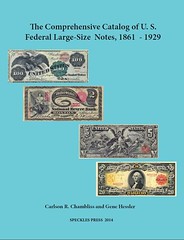 The Comprehensive Catalog of U. S. Federal Large-Size Notes, 1861 – 1929,
The Comprehensive Catalog of U. S. Federal Large-Size Notes, 1861 – 1929,
Authors Carlson R. Chambliss and Gene Hessler
Foreword by: Martin Gengerke and Douglas Murray
Speckles Press 2014
Reviewed by John and Nancy Wilson, NLG

INTERVIEW: DOUG WINTER
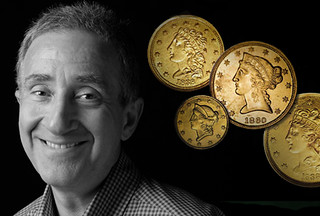 CM: When one thinks about U.S. gold coinage and the personalities most tied to the field, two names are bound to come up: you, and David Akers. What was your relationship with David Akers and how did his series of books change the landscape for collecting classic U.S. gold?
CM: When one thinks about U.S. gold coinage and the personalities most tied to the field, two names are bound to come up: you, and David Akers. What was your relationship with David Akers and how did his series of books change the landscape for collecting classic U.S. gold?
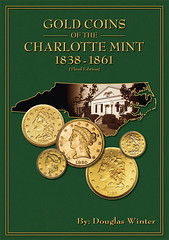 CM: You co-authored your own series of U.S. gold coin guides with Michael Fuljenz. How did your approach differ from what David Akers had put together?
CM: You co-authored your own series of U.S. gold coin guides with Michael Fuljenz. How did your approach differ from what David Akers had put together?
SHERATON COIN COMPANY FOUNDER ERNEST HENDERSON
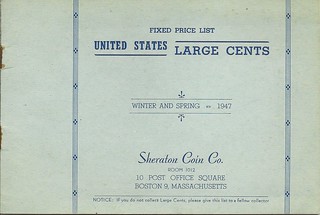 I noticed in your January 9, 2011 issue of The E-Sylum that you have a query, “Can anyone tell us more about Henderson the numismatist?” In that article, you also included the Sheraton Coin Company’s 1947 fixed price list.
I noticed in your January 9, 2011 issue of The E-Sylum that you have a query, “Can anyone tell us more about Henderson the numismatist?” In that article, you also included the Sheraton Coin Company’s 1947 fixed price list.
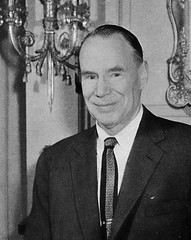 My father Ernest Henderson was an avid collector. He used to talk about the rare coins he had, and how often it would happen that people who knew of his love of coins would send him coins on approval, but alas, they thought that they could improve the value of the coins if they polished them and made them nice and shiny! He carefully taught his children that part of the value of coins resided in their patina and we should never polish a coin. He also talked about the value of getting the best, and then once, when he was feeling philosophical, he told me that when thinking of the investment side of coins, “In general coins appreciate in dollar value at about the same rate as the stock market, but they’re a lot more fun.”
My father Ernest Henderson was an avid collector. He used to talk about the rare coins he had, and how often it would happen that people who knew of his love of coins would send him coins on approval, but alas, they thought that they could improve the value of the coins if they polished them and made them nice and shiny! He carefully taught his children that part of the value of coins resided in their patina and we should never polish a coin. He also talked about the value of getting the best, and then once, when he was feeling philosophical, he told me that when thinking of the investment side of coins, “In general coins appreciate in dollar value at about the same rate as the stock market, but they’re a lot more fun.”
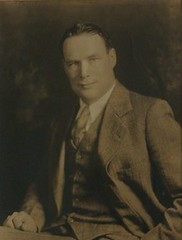 For the occasion of the dinner honoring Ambassador Caccia, my father served tea with a leaf or two of the original Boston Tea Party tea mixed in with regular orange pekoe. However, as he announced to the British ambassador, he didn’t want to embarrass the ambassador by offering him tea for which the duty hadn’t been paid.
For the occasion of the dinner honoring Ambassador Caccia, my father served tea with a leaf or two of the original Boston Tea Party tea mixed in with regular orange pekoe. However, as he announced to the British ambassador, he didn’t want to embarrass the ambassador by offering him tea for which the duty hadn’t been paid.
Mitzi Henderson Perdue
THE BOOK BAZARRE
1792 HALF DISME LISTING UPDATE
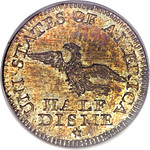 Two weeks ago I asked for reports from people who owned or knew of 1792 half dismes. I received four reports on the first day, one on the second day and none since. The information provided was helpful in establishing pedigrees for surviving examples.
Two weeks ago I asked for reports from people who owned or knew of 1792 half dismes. I received four reports on the first day, one on the second day and none since. The information provided was helpful in establishing pedigrees for surviving examples.
NOTES FROM E-SYLUM READERS: AUGUST 31, 2014
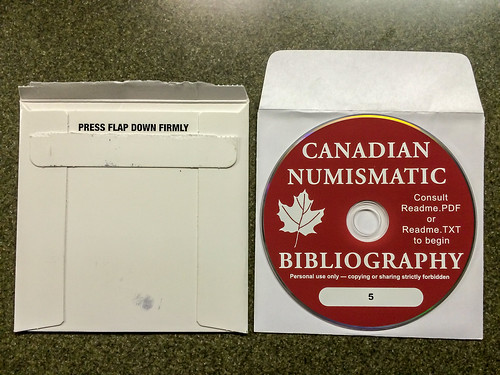
 Pete Smith writes:
Pete Smith writes:
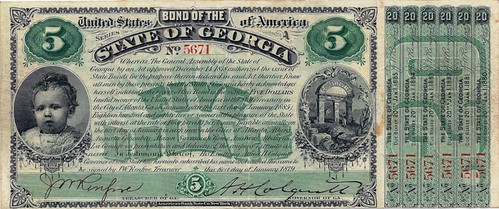
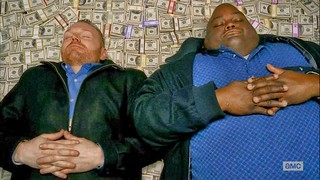 In last week's edition someone mentioned that he thought that the photo of two men laying on money was from Breaking Bad not Rush Hour 2. I can confirm that the image came from Breaking Bad season 5 episode 10 "Buried"
In last week's edition someone mentioned that he thought that the photo of two men laying on money was from Breaking Bad not Rush Hour 2. I can confirm that the image came from Breaking Bad season 5 episode 10 "Buried"
THE BUSINESS OF HOLLYWOOD MOVIE MONEY
(www.coinbooks.org/esylum_v17n34a14.html)
NOTES FROM E-SYLUM READERS: AUGUST 24, 2014 : More on Hollywood Movie Money
(www.coinbooks.org/club_nbs_esylum_v17n35.html)
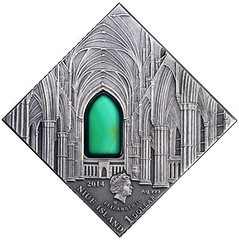 In response to your question about Niue - it's a quite small island in the Pacific that is officially "self-governing but in free association with New Zealand", which I guess makes it an NZ dependency of sorts. Looking at the plethora of CLO's (I much prefer to say "coin-like objects" than NCLT if I can tell it like it is!) from places such as Niue and the Cook Islands, whose themes usually have very little to do with either of those places, it's clear that they produce a benefit for both parties - the makers/marketers and the tiny countries whose names appear on these issues.
In response to your question about Niue - it's a quite small island in the Pacific that is officially "self-governing but in free association with New Zealand", which I guess makes it an NZ dependency of sorts. Looking at the plethora of CLO's (I much prefer to say "coin-like objects" than NCLT if I can tell it like it is!) from places such as Niue and the Cook Islands, whose themes usually have very little to do with either of those places, it's clear that they produce a benefit for both parties - the makers/marketers and the tiny countries whose names appear on these issues.
ANSWER: MORGAN DOLLAR PRINTING BLOCK

THE AUGUSTIN DUPRÉ ARCHIVE
The March-May issue of the MCA Advisory, the journal of the Medal Collectors of America, had a well-illustrated article by John W. Adams about the hoard and its sale. With permission, here is an excerpt with a small sampling of the article's plethora of great illustrations.
-Editor
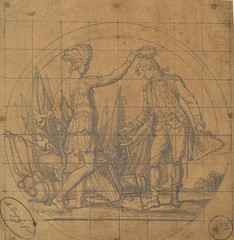
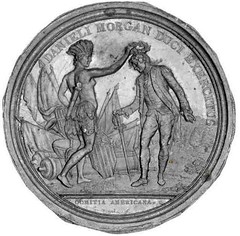
Sketch and uniface obverse cliché of Daniel Morgan medal
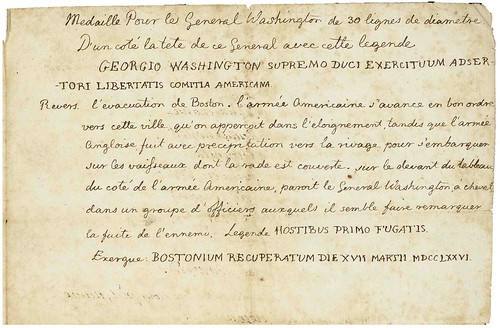
Washington Before Boston medal description
in Thomas Jefferson's hand
BONHAM'S TO SELL AUGUSTIN DUPRÉ ARCHIVE
(www.coinbooks.org/esylum_v17n02a07.html)
AN AUGUSTIN DUPRÉ GALLERY
(www.coinbooks.org/esylum_v17n02a08.html)
WILLIAM S. APPLETON'S REMARKS ON AUGUSTIN DUPRÉ
(www.coinbooks.org/esylum_v17n02a09.html)
MORE ON M. DAVID AND HULMEVILLE BANKNOTES
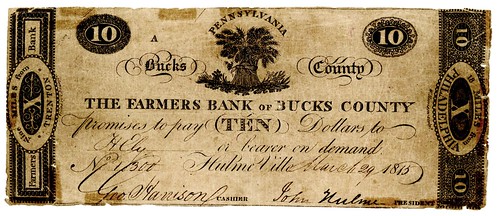
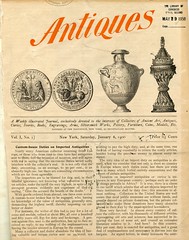 I attach the page 1 of issue 1 of David’s pioneering Antiques magazine, which contained information including about coins and was published only in two issues, January and February 1900. I have the ex-Library of Congress copies plus David’s letter concerning them.
I attach the page 1 of issue 1 of David’s pioneering Antiques magazine, which contained information including about coins and was published only in two issues, January and February 1900. I have the ex-Library of Congress copies plus David’s letter concerning them.
All good wishes,
qdbarchive@metrocast.net
Box 539
Wolfeboro Falls, NH 02896
QUERY: M. DAVID AND HULMEVILLE BANKNOTES
(www.coinbooks.org/esylum_v17n35a10.html)
'NO GOD BUT ALLAH' OVERSTAMP REAPPEARS

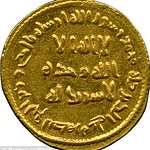 The first ever coin to record the famous Islamic phrase 'There is no God but Allah' is set to sell for hundreds of thousands of pounds when it goes under the hammer. The historic gold dinar from 690 AD was minted in Damascus by the Umayyad dynasty - the first Arab empire, which stretched from Spain in the west to India in the east at the peak of its power.
The first ever coin to record the famous Islamic phrase 'There is no God but Allah' is set to sell for hundreds of thousands of pounds when it goes under the hammer. The historic gold dinar from 690 AD was minted in Damascus by the Umayyad dynasty - the first Arab empire, which stretched from Spain in the west to India in the east at the peak of its power.
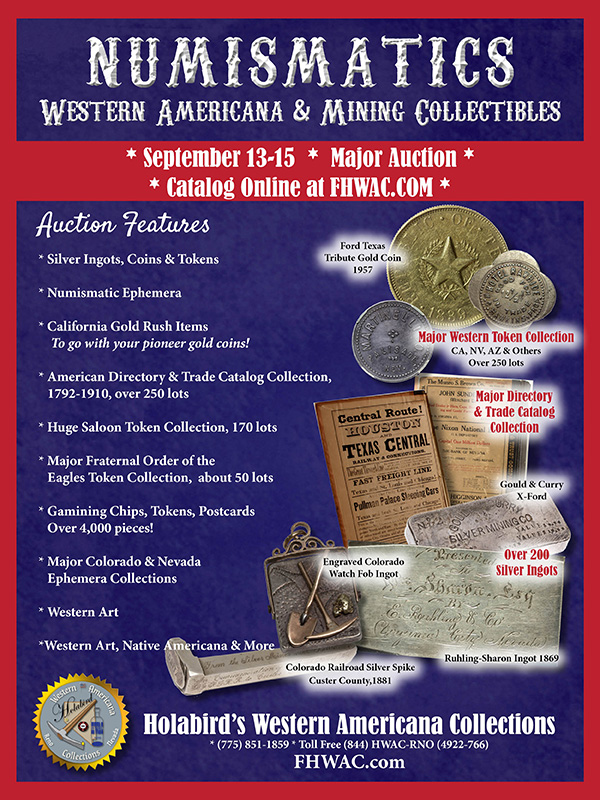
OPINIONS SOUGHT: POCKET PIECE VERSUS DISPLAY?
HARVEY STACK ON THE U.S. MINT'S PROFITEERING
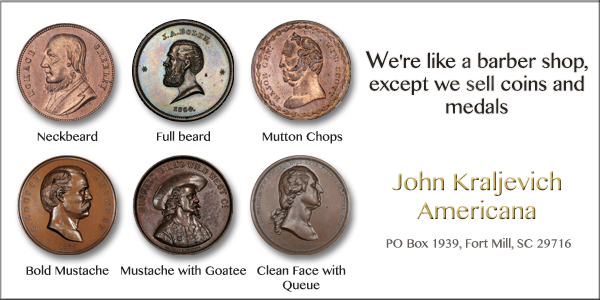
THE NUMISMATIC EDUCATION OF DAVID T. ALEXANDER
 I have spent the last 40 years as a professional auction cataloger for several prominent firms. As a young collector in the 1950’s, however, I had little knowledge of numismatic auctions, how and why they worked, and I was not alone. As a staff writer for Coin World from 1974 to 1981 I became very familiar with the finished product: the many U.S. and world auction catalogs that crossed my desk each week.
I have spent the last 40 years as a professional auction cataloger for several prominent firms. As a young collector in the 1950’s, however, I had little knowledge of numismatic auctions, how and why they worked, and I was not alone. As a staff writer for Coin World from 1974 to 1981 I became very familiar with the finished product: the many U.S. and world auction catalogs that crossed my desk each week.
MACHINE-ENGRAVED GEOMETRIC PATTERNS ON BANKNOTES
Andrew Hurle
 Ornamental art engraved by geometric lathes in the 1800s is as beautiful and instantly credible today as when it was created.
Ornamental art engraved by geometric lathes in the 1800s is as beautiful and instantly credible today as when it was created.
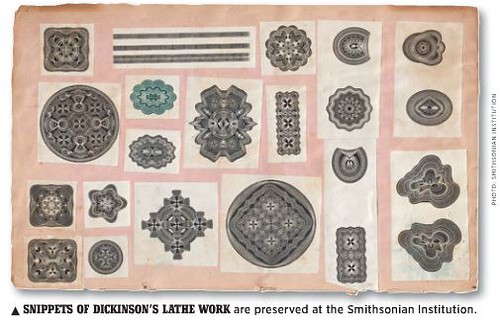
1941 PHILIPPINE TREASURY NOTES


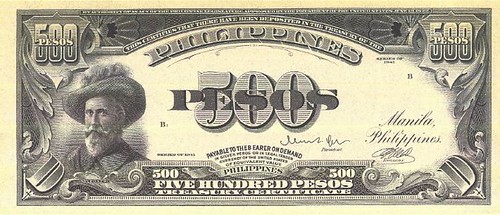
THE BOOK BAZARRE
CONFEDERATE QUARTERMASTER'S AGENT ORESTES PARMENO CHAFFEE
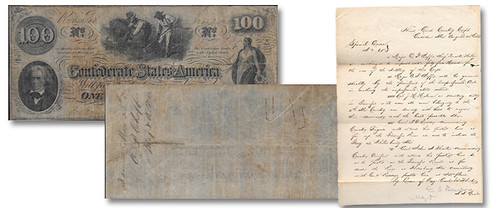
/2678/ArticleID/64713/The-Curious-Story-of-Confederate
-Major-Orestes-Parmeno-Chaffee-.aspx)
NUMISMATIC GODFATHERS, LT. COLONELS, AND POOBAHS
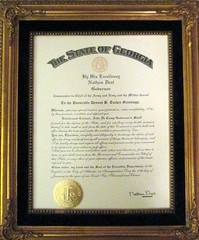 Not too long ago, for my work in book publishing, I was granted the title of Lieutenant Colonel, Aide de Camp, Governor’s Staff by the State of Georgia. While most Georgia colonels mistake this as a purely honorary sinecure, or use it solely to plump up their curricula vitae, I’m not afraid to take full advantage of holding a command position in the state’s military.
Not too long ago, for my work in book publishing, I was granted the title of Lieutenant Colonel, Aide de Camp, Governor’s Staff by the State of Georgia. While most Georgia colonels mistake this as a purely honorary sinecure, or use it solely to plump up their curricula vitae, I’m not afraid to take full advantage of holding a command position in the state’s military.
AAS ACCEPTS NATIONAL HUMANITIES MEDAL
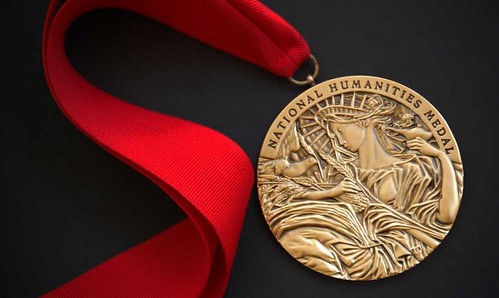
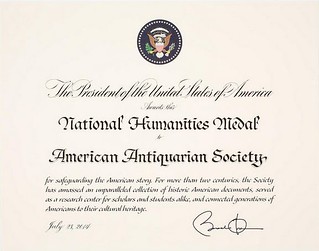 As I stood there next to the President as our citation (see right) was read, I opened the floodgates of my memory and tried to think of every person who has played a part in assembling these collections, in preserving and making them accessible, and in engaging a broad constituency to appreciate and utilize these amazing resources. I was so honored to be there to represent each and every person who has help to build AAS into the great institution it is today.
As I stood there next to the President as our citation (see right) was read, I opened the floodgates of my memory and tried to think of every person who has played a part in assembling these collections, in preserving and making them accessible, and in engaging a broad constituency to appreciate and utilize these amazing resources. I was so honored to be there to represent each and every person who has help to build AAS into the great institution it is today.
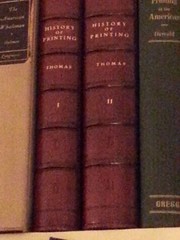 Joining me at the White House to represent the AAS were our Council chairman Sid Lapidus and Councilor Bill Reese. Given time before the awards ceremony to roam freely through the first two floors of the mansion, Bill and I immediately set out on a quest. We had heard from a fellow bibliophile that the White House copy of Isaiah Thomas’s two-volume History of Printing in America was in great peril: he had seen one volume shelved on the first floor and the other on the second. Oh, the horror of it! But our worry was for naught, as eagle-eyed Bill quickly spotted the two volumes properly reunited on the top shelf of the first floor library, as you can see to the right.
Joining me at the White House to represent the AAS were our Council chairman Sid Lapidus and Councilor Bill Reese. Given time before the awards ceremony to roam freely through the first two floors of the mansion, Bill and I immediately set out on a quest. We had heard from a fellow bibliophile that the White House copy of Isaiah Thomas’s two-volume History of Printing in America was in great peril: he had seen one volume shelved on the first floor and the other on the second. Oh, the horror of it! But our worry was for naught, as eagle-eyed Bill quickly spotted the two volumes properly reunited on the top shelf of the first floor library, as you can see to the right.
THE JONAS SALK CONGRESSIONAL GOLD MEDAL
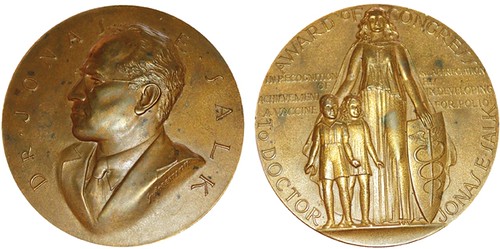
Jonas Salk Congressional Gold Medal (bronze example)
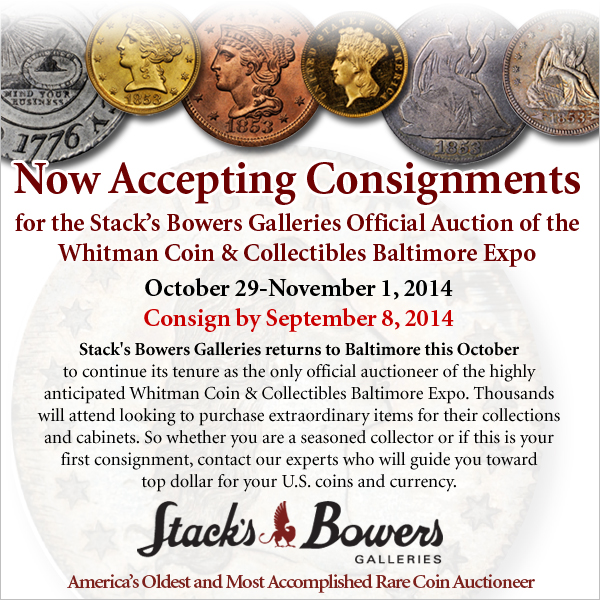
HOLEY DOLLAR AND DUMP STOLEN FROM LIBRARY
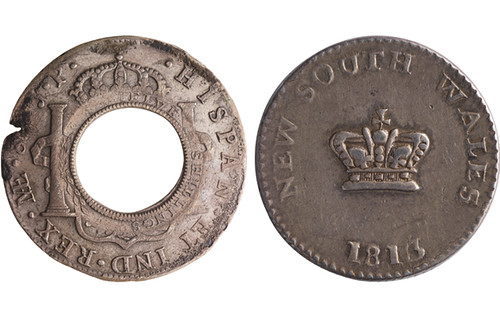
--_dump-coins-among-those-stolen-from-exhibit-in-aus.html)
THE NOTORIOUS COUNTERFEITER ALBERT TALTON
BALDWINS HONG KONG COIN AUCTION 57 RESULTS
Baldwin’s Hong Kong Coin Auction
Achieves US$2,513,400
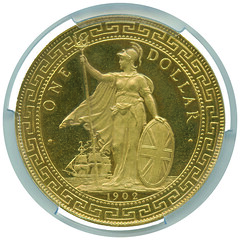
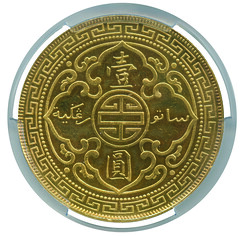
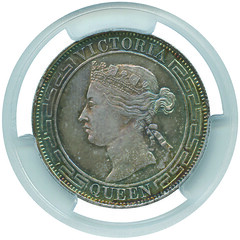
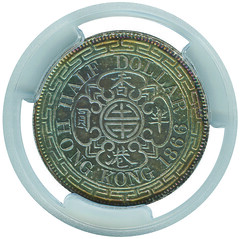

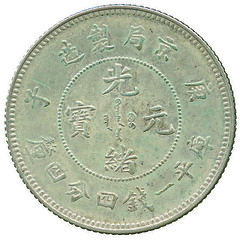
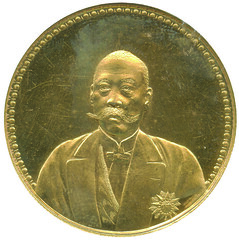
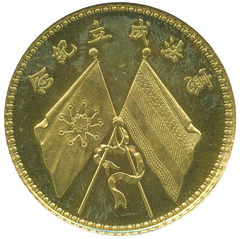
Visit us at www.baldwin.co.uk
Follow us on Twitter @BaldwinsCoins
Find us on Facebook /BaldwinsCoins
THE BOOK BAZARRE
KÜNKER AUCTION SALES 253-257
More than 1,600 lots of orders and decorations will be called on 4 October, 2014. In the section Germany, the Oldenburg Collection assembled by F. Beyreiß stands out. It consists of almost 150 objects, including – and this is the unrivalled highlight – the set of the Golden Great Cross with Chain of the Oldenburg House and Merit Order of Duke Peter Frederick Louis (150, II, estimate: 20,000 euros).
Künker continues its auction on Monday, 6 October, 2014, with coins and medals from medieval and modern times. We could easily dwell on this alone for pages since this area contains many reasonably estimated, rare and splendidly preserved pieces featuring good provenances that make the heart of every collector beat faster. A case in point is the series of Carolingian coins, including a denarius of Louis the Pious from Melle, with a presentation of the coining tools on its reverse (2034, VF, estimate: 2,000 euros). Or how about a pattern for a 5 francs piece, issued by Bonapartists in 1874, whose obverse is graced by the portraits of the son of the brought down emperor as Napoleon IV (2142, EF-BU, estimate: 1,500 euros). The testone of Alfonso d’Este from Ferrara (2261, VF, estimate: 2,000 euros) will surely find as many fans as the giulio bearing the portrait of controversial Julius II and the mint mark of the Fugger family (2278, VF, estimate: 1,500 euros) or the double ducatoni 1641 from Milan featuring the portrait of Philip IV (2314, VF-EF, estimate: 25,000 euros).
The gold coins are scheduled to be auctioned off on 9 October, 2014. Naturally, there are many more coins on offer than we could ever mention in such a preview. The focus in regard to the foreign countries is being laid on England – with a ryal worth 15 shillings of Catholic Mary I of England, minted in London in 1553 (6630, VF, estimate: 30,000 euros), on Italy – with a full and a half augustalis (6704, VF+, estimate: 8,000 euros, and 6705, VF-EF, estimate: 6,000 euros) as well as on Switzerland – with ample series of rare gold coins coming from Berne and Zurich, such a Zurich ducat without date (c. 1580) (6780, VF-EF, estimate: 4,000 euros).
Roughly 1,300 lots containing ancient coins constitute the last part of the Künker auction week. But there will be no such thing as a cool down because this catalog, too, is made up of highlights, presenting several superbly preserved gems with the ‘Collection of an Aesthetic’. The aficionado is first introduced to more than 280 lots of Celtic and Greek coins, after which numerous denarii from the Roman Republic follow which come in an extraordinarily good quality, but there are also bronze coins from Roman Imperial Times available bearing excellent portraits.
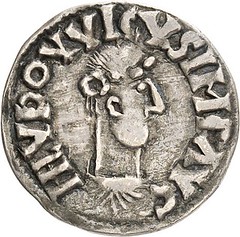
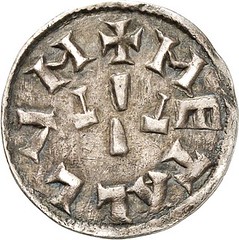
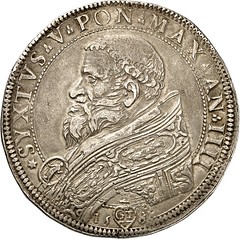
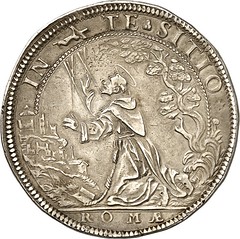


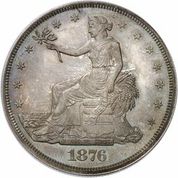
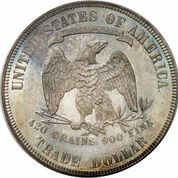
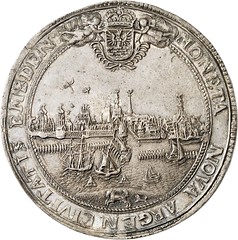
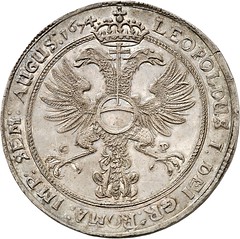
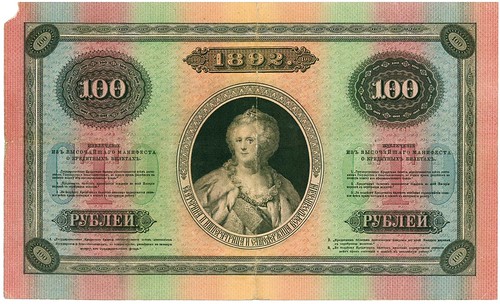

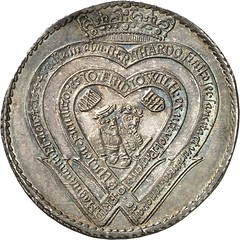
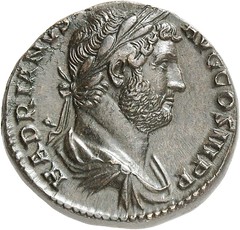

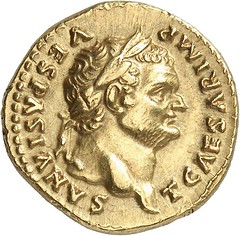
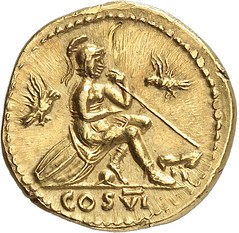
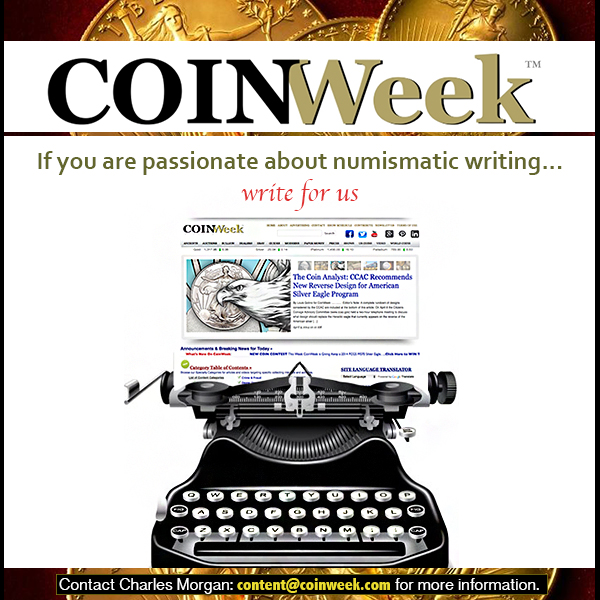
GORNY & MOSCH AUCTION SALES 224-226
Gorny & Mosch
Auction sales 224-226
They are the icons of pre-monetary money, these copper ingots in the shape of an animal hide, made after 1600 B. C. With one of these pieces the auction sale kicks off on 13 October, 2014. The object with its weight of 26.6kg is estimated at 25,000 euros.
Strictly speaking, this preview focusing on the most expensive items is not appropriate since one does not have to have lots of money to acquire some attractive pieces as an addition to one’s collection. If you find that hard to believe, please browse through auction sale catalog #225. It includes, with estimates that are not that high, artistically and historically interesting coins that were produced by cities that are difficult to locate even for the expert. A case in point is the trihemiobol from the Thessalian city of Kierion that depicts the nymph Arne on the reverse giving prophecies with astragals (1393, about EF, estimate: 500 euros).
The auction sale “Medieval and modern times” starts with a collection that is unparalleled on the market so far. Werner Jaggi used to collect everything related to the Catholic faith. He assembled a huge collection of religious art. A small part of this were numismatic testimonies of religious customs as it found expression in pendants, crosses, coined amulets and medals. These objects are intriguing not only to the one interested in art history. The local collector, too, discovers items he never knew before. They bear witness to a time when reason was not the universal standard. The stories they tell sound unbelievable to the modern ear, e.g. the one of the rich peasant who only fulfilled his vow when his hen had laid an egg on whose shell he believed to see Virgin Mary with an aureole. The cloister of Maria Stern, which derived its name from this story, attracted people from far and wide. The egg still is part of the coat of arms of the Bavarian city of Odelzhausen where the cloister of Odelzhausen used to be located. Two lots of the collection are devoted to this legend (3189 and 3190, both VF, 150 resp. 100 euros).
Apart from that, Werner Jaggi collected religious and papal medals, so that the connoisseur can choose from an ample range of offers, including examples from the Renaissance, like a rare medallion of Hans Reinhardt the Elder that depicts the Apokalyptic Christ on the obverse and God the Father with the lamb surrounded by the 24 Elders on the reverse (3369, extremely fine original cast, estimate: 2,500 euros).
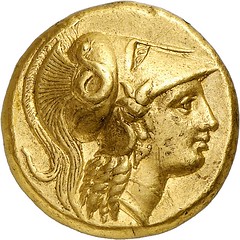
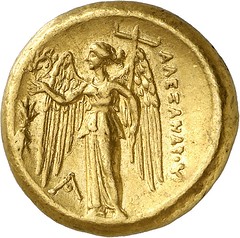

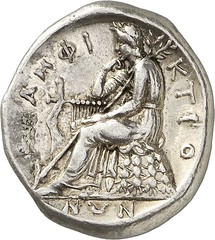
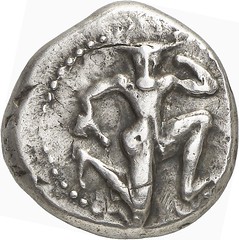
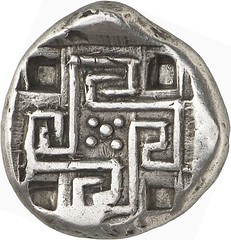
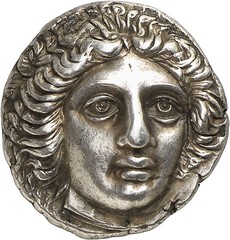

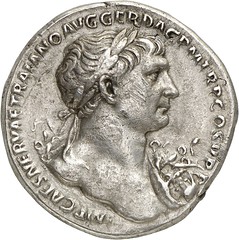
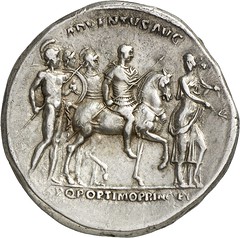
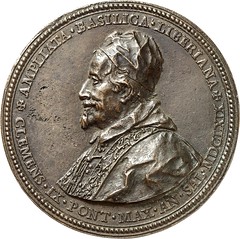

RAREST CIRCULATING U.K. COINS
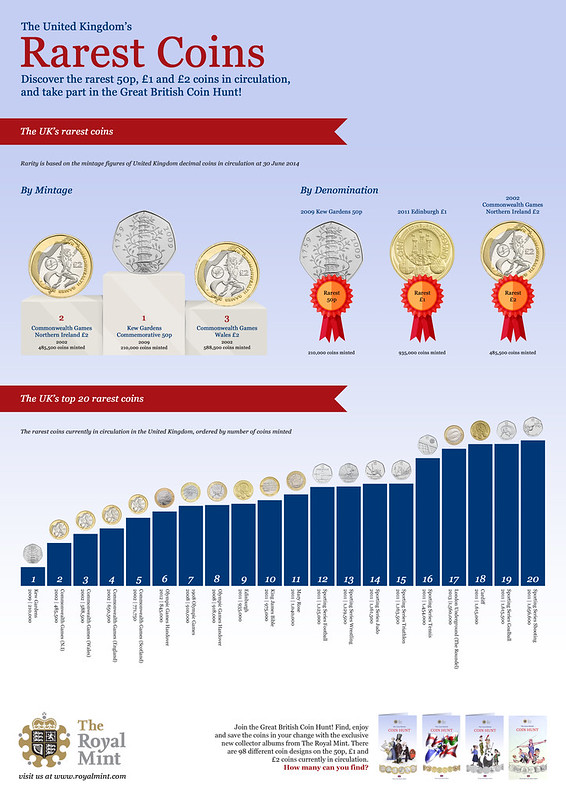
THE BOOK BAZARRE
FIGHT CONTINUES OVER 1974-D ALUMINUM CENT
 The fight for a rare penny isn’t over yet.
The fight for a rare penny isn’t over yet.
3-D IMAGING REVEALS AND RECONSTRUCTS OBSCURED ARTIFACTS
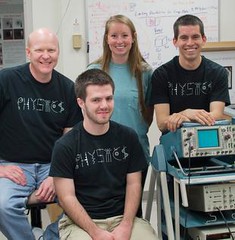 Students in Davidson College’s physics department have been examining artifacts from a long-ago grounded ship off the North Carolina coast that state officials say was Blackbeard’s Queen Anne’s Revenge. But this isn’t a treasure hunt.
Students in Davidson College’s physics department have been examining artifacts from a long-ago grounded ship off the North Carolina coast that state officials say was Blackbeard’s Queen Anne’s Revenge. But this isn’t a treasure hunt.
WHISKEY FLASK IN A HOLLOW BOOK
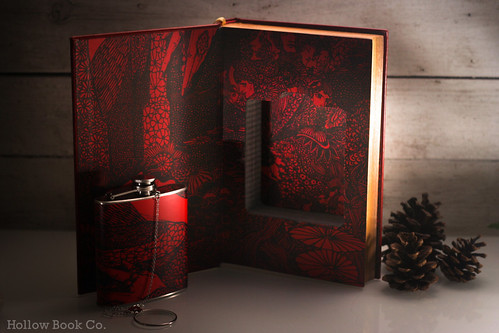
ARTISTS LURES GOLDDIGGERS TO BRITISH BEACH
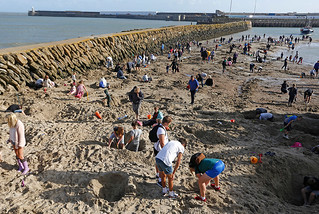 Thirty gold bars have been buried on a beach in Britain by a German artist, prompting a flood of bounty hunters with metal detectors to seek their fortune Friday.
Thirty gold bars have been buried on a beach in Britain by a German artist, prompting a flood of bounty hunters with metal detectors to seek their fortune Friday.
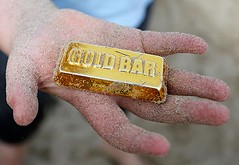 So what do these bars actually LOOK like? Here's a picture of a fake one made of plastic, apparently buried at the beach as well. Neither of the publications had images of the real bars, although the Guardian had a description. It'll be interesting if one of these "Made in London" bars turns up in the numismatic market. Could be a rarity someday, and who knows - maybe one will turn up on that beach 100 years from now.
So what do these bars actually LOOK like? Here's a picture of a fake one made of plastic, apparently buried at the beach as well. Neither of the publications had images of the real bars, although the Guardian had a description. It'll be interesting if one of these "Made in London" bars turns up in the numismatic market. Could be a rarity someday, and who knows - maybe one will turn up on that beach 100 years from now.
Or are there really any gold bars at all? Could it be a hoax? All part of the fun, I guess. We'll only know if someone reports their find to the media and a follow-up story is written. Let us know if you come across any reports.
-Editor
CATCHING SMUGGLERS BY THE SMELL OF THEIR MONEY
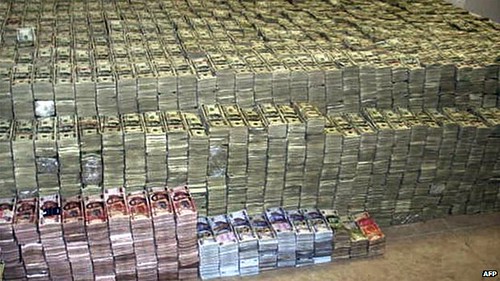
FEATURED WEB PAGE: ARTISTRY OF AFRICAN CURRENCY
This week's Featured Web Page is the online exhibit "The Artistry of African Currency" from the Smithsonian Institution.

africa.si.edu/exhibits/site/

